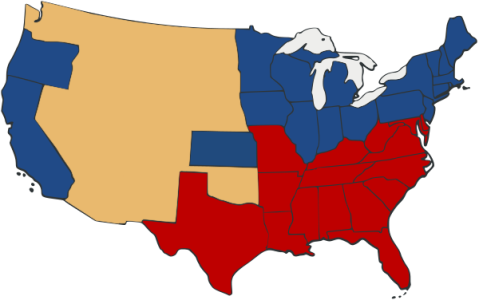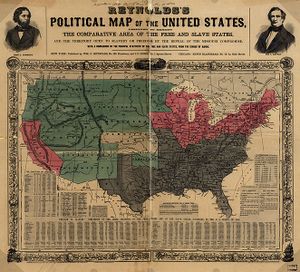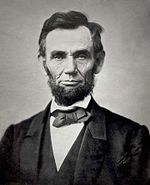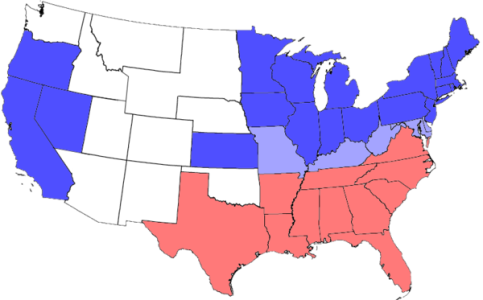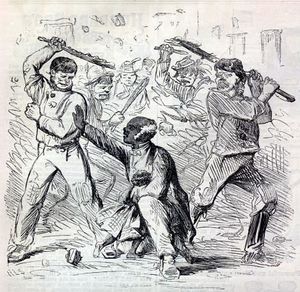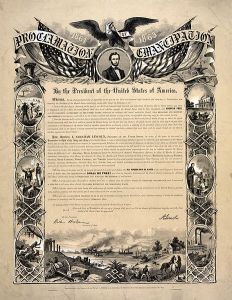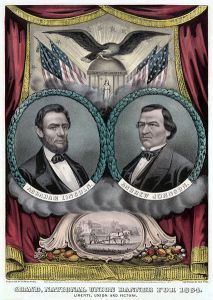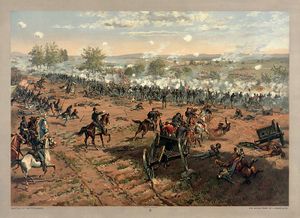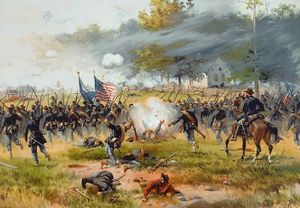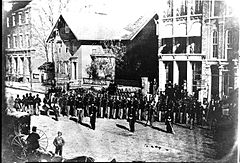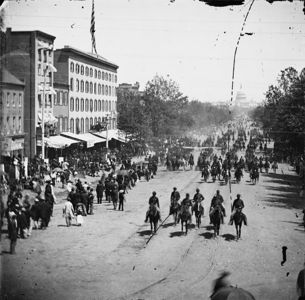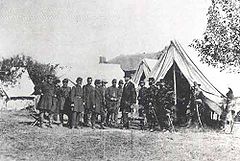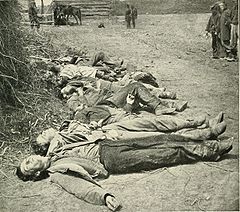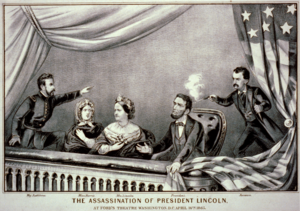美国内战和重建:1861-1877 年
根据 Aline Helg 的演讲改编[1][2][3][4][5][6][7]
美洲独立前夕 ● 美国的独立 ● 美国宪法和 19 世纪早期社会 ● 海地革命及其对美洲的影响 ● 拉丁美洲国家的独立 ● 1850年前后的拉丁美洲:社会、经济、政策 ● 1850年前后的美国南北部:移民与奴隶制 ● 美国内战和重建:1861-1877 年 ● 美国(重建):1877 - 1900年 ● 拉丁美洲的秩序与进步:1875 - 1910年 ● 墨西哥革命:1910 - 1940年 ● 20世纪20年代的美国社会 ● 大萧条与新政:1929 - 1940年 ● 从大棒政策到睦邻政策 ● 政变与拉丁美洲的民粹主义 ● 美国与第二次世界大战 ● 第二次世界大战期间的拉丁美洲 ● 美国战后社会:冷战与富裕社会 ● 拉丁美洲冷战与古巴革命 ● 美国的民权运动
自美国建国以来,美国南北方在奴隶制问题上的紧张关系就形成了一道深深的裂痕。工业化和日益城市化的北方认为奴隶制在道德上应受到谴责,在经济上也是过时的。另一方面,农业经济严重依赖奴隶劳动的南方则将奴隶制视为其社会和经济不可分割的一个基本方面。两个地区之间明显的经济、文化和政治差异加剧了这种分歧,凸显了年轻的共和国中已经普遍存在的对立情绪。司法判决在加剧紧张局势方面发挥了作用,特别是最高法院于 1857 年在 "德雷德-斯科特诉桑德福德 "一案中做出的判决,该判决剥夺了非洲裔美国人的公民权,并确认了各州在奴隶制立法方面的优先权。在这一关键问题上的对立最终导致了 1861 年南北战争的爆发,这场悲惨而血腥的战争至今仍是美国历史上死亡人数最多的冲突,约有 62 万士兵和数目不详的平民丧生。
内战和随后的重建是了解美国历史上争取自由、平等和公民权斗争的关键时期。战后通过的《宪法》第 13、14 和 15 条修正案标志着非裔美国人的权利在立法方面取得了重大进展。然而,在重建时期,由于 1873 年 "屠宰场案 "等司法判决以及南方各州通过的歧视性法律(即 "吉姆-克罗法"),这些成果在很大程度上受到了阻碍。这些法律的实施维持了系统性的种族隔离,标志着向平等发展的倒退。这段法律上和事实上不平等的黑暗时期持续了近一个世纪,其残余影响直到二十世纪五六十年代的民权运动才得以完全消除。
因此,南北战争和重建不仅说明了塑造美国国家的冲突和妥协,也说明了通往正义和平等之路的复杂性。这一时期的经验教训提醒我们,社会进步往往需要持续的努力和斗争,面对根深蒂固的社会不平等,进步可能是脆弱的、可逆的。
战争的原因
美国内战的起因源于一系列复杂的、多方面的社会经济和政治因素,其中奴隶制及其西扩是争论的焦点。美国的西扩加剧了奴隶制问题,凸显了南北双方在奴隶制向新领土扩张问题上的深刻分歧。1820 年的密苏里妥协法案允许密苏里州作为奴隶州、缅因州作为自由州加入联邦,试图维持奴隶制州与非奴隶制州之间的平衡,但这只是暂时的解决办法。1850 年的妥协法案包含一系列立法措施,旨在缓和蓄奴州与非蓄奴州之间的紧张关系,但也只是在未愈合的伤口上贴了一张创可贴,并没有从根本上解决问题。此外,1854 年的《堪萨斯-内布拉斯加法案》允许各地区自行决定是否蓄奴,导致暴力事件增加,奴隶制支持者和反对者之间的紧张关系加剧。最高法院在 "德雷德-斯科特诉桑德福德 "一案中的判决剥夺了非裔美国人的公民权,并确认了各州就奴隶制进行立法的权利,这进一步激化了人们的情绪。这些妥协和政治决定只是治标不治本的措施,没有解决奴隶制的根本问题。相反,它们加剧了紧张局势,扩大了南北各州之间的差距,凸显出政治体制无法找到双方都能接受的持久解决方案。这些日益加剧的紧张局势和不充分的妥协反映在 1861 年南北战争的爆发上,标志着自美国诞生以来就一直在酝酿的深刻而持久的分歧达到了顶点。
1850 年逃奴法》是《1850 年妥协法案》的重要条款之一,成为南北双方在奴隶制问题上不可调和分歧的有力象征。该法案要求联邦当局以及普通北方公民为捕获逃亡奴隶并将其归还南方奴隶主做出贡献,这激起了许多北方人的愤慨和反对。该法不仅被视为联邦政府对自由州事务的不可容忍的干涉,也被视为对反对奴隶制者的道德侮辱。这导致了北方的积极抵制,"地下铁路"(Underground Railroad)等网络在北方发展起来,帮助逃亡的奴隶到达安全的地方。该法律加剧了两个地区之间日益增长的不信任和敌意,凸显了在奴隶制问题上深刻的道德和法律分歧。1857 年最高法院在 "德雷德-斯科特诉桑德福 "一案中的判决更是加剧了这种紧张关系。通过认定奴隶即使居住在自由州也仍然是奴隶,以及剥夺非裔美国人的公民权,最高法院不仅沉重打击了废奴主义者的努力,还发出了自由州的权利和意愿从属于奴隶主利益的明确信息。逃奴法案》和 "德雷德-斯科特 "案的判决共同造成了南北方之间更加不信任和对立的气氛,粉碎了妥协的尝试,凸显了国家在奴隶制问题上的道德和政治破产。这些事件揭示了在一个因种族、权利和自由等问题而严重分裂的国家中试图维持一个脆弱的联盟所面临的挑战和内在矛盾,并为 1861 年爆发的不可避免的冲突铺平了道路。
奴隶制及其向新领土扩张的问题是最终导致美国内战的紧张局势的核心。这场冲突的核心是南北双方在奴隶制的本质及其在国家中的作用问题上存在着不可调和的深刻分歧。工业经济蓬勃发展的北方日益摆脱对奴隶制的依赖,认为奴隶制在道德上应受到谴责,在经济上也是落后的。许多北方人认为奴隶制与自由和平等的建国理想格格不入。反对将奴隶制扩张到新领土和新州被视为遏制这种被认为从根本上不公正的制度的一种手段。南方则严重依赖奴隶制来支持其农业经济,尤其是棉花种植园。对许多南方人来说,奴隶制不仅被视为一种合法权利,而且也是其生活方式和文化中不可分割的重要方面。奴隶制向新领土的扩张被视为南方经济生存和繁荣的必要条件。1820 年密苏里妥协法案》、《1850 年妥协法案》和《1854 年堪萨斯-内布拉斯加法案》等通过立法妥协寻求共同点的努力只是推迟了问题的解决,而没有解决问题。1850 年的《逃奴法案》和最高法院 1857 年对 "德雷德-斯科特诉桑德福德 "一案的判决等措施加剧了双方的紧张关系,削弱了双方的信任。由于无法调和这些根本分歧,裂痕随着时间的推移不断扩大,不仅涉及立法和经济问题,还触及到两个地区的价值观、身份和愿望。1860 年,反对扩大奴隶制的候选人亚伯拉罕-林肯当选,成为压垮骆驼的稻草,促使南方各州分离。美国内战是两种截然相反的美国理念长期斗争的必然结果。它反映了在权利、自由和国家认同等根本问题上不可逾越的深刻分歧,这些问题无法通过政治手段解决,最终只能在战场上解决。
从 1850 年起,随着《逃亡奴隶法》(1850 年妥协法案的一部分)的通过,美国逃亡奴隶的处境变得更加复杂。该法案规定,联邦和地方当局以及普通公民有义务协助抓捕逃亡奴隶并将其送回奴隶主所在的州。这意味着,即使在废除奴隶制的北方各州,逃亡的奴隶也不安全,可能会被逮捕并送回南方。面对日益加剧的威胁,许多逃亡奴隶到1834年废除奴隶制的加拿大寻求避难。加拿大成为 "地下铁路 "的首选目的地。"地下铁路 "是一个由秘密路线和安全屋组成的有组织的网络,用于帮助奴隶逃往自由。在加拿大寻求避难的逃亡奴隶人数增加不仅是《逃亡奴隶法案》的直接结果,也对北方的废奴运动产生了重大影响。逃亡奴隶的故事和帮助他们的努力增强了废奴主义者的决心和承诺。这些故事生动地说明了奴隶制的恐怖和不公正,激发了公众对废奴事业的更多支持。此外,《逃亡奴隶法》激起了许多北方公民的愤怒,他们不一定是废奴派,但对协助抓捕和遣返逃亡奴隶的法律义务感到愤慨。反对该法案有助于将奴隶制问题政治化,加深南北之间的分歧。逃亡奴隶法》不仅改变了逃亡奴隶自身的处境,还影响了全国范围内关于奴隶制的辩论,并在南北战争爆发前的关键时期帮助形成了废奴运动。逃往加拿大成为追求自由和奴隶制不人道的有力象征,为最终导致终结奴隶制的战争推波助澜。
弗雷德里克-道格拉斯是美国废奴运动最具代表性和影响力的人物之一。他出生在奴隶制家庭,20 岁时成功逃脱,并将余生献给了反对这种不人道制度的斗争。道格拉斯是一位才华横溢、魅力四射的演说家,能够吸引和说服听众。他用自己的才华讲述自己的故事,让成千上万无法为自己发声的奴隶发出声音。通过他的演讲和著作,他向听众揭示了奴隶制的残酷现实,否则听众可能只能抽象地了解这些暴行。他的著作《美国奴隶弗雷德里克-道格拉斯的生平叙事》于 1845 年出版,令许多读者感到震惊。在这本详细的自传中,道格拉斯描述了他的奴隶生活,包括他每天遭受的身体虐待和侮辱。不仅如此,他还讲述了他的思想觉醒和对自由的渴望,这使他成为那个时代最重要的思想家和活动家之一。道格拉斯的叙述不仅仅是一部自传,它还是对奴隶制的控诉,是争取废除奴隶制的有力武器。它不仅强调了奴隶制在肉体上的残酷,还强调了被奴役者的非人化和精神奴役。道格拉斯展示了奴隶制是如何腐蚀奴隶主和破坏美国民主的基本原则的。道格拉斯的故事和慷慨激昂的演讲帮助改变了公众舆论,为废奴事业争取到了支持。他成为人类精神的生动象征,象征着人类有能力战胜压迫,争取自由和尊严。除了作为作家和演说家,道格拉斯还是一位积极的运动家,他支持帮助逃亡奴隶的努力,与其他主要废奴主义者密切合作,甚至在南北战争期间担任亚伯拉罕-林肯等总统的顾问。弗雷德里克-道格拉斯对废除奴隶制事业的贡献不可估量。他将自己的苦难转化为对正义和人性的强烈呼吁,帮助推动了最终导致美国废除奴隶制的力量。
哈丽雅特-比彻-斯托的小说《汤姆叔叔的小屋》出版于 1852 年,是一部激发废奴运动并深刻影响美国公众意识的重要文学作品。小说以凄美的写实手法和深切的同情描写了南方各州被奴役者的日常生活、苦难和人性。汤姆叔叔的小屋》的影响是直接而深刻的。它以独特而人性化的视角揭示了奴隶制,使往往远离奴隶制现实的北方读者了解到奴隶制的恐怖。书中的人物,如汤姆叔叔、小伊娃和母亲伊莱扎,成为奴隶制辩论的象征,将奴隶人性化,引起读者的共鸣和同情。该书在商业上的成功在当时是史无前例的。该书在 10 年内卖出了 1 000 多万册,而当时的人口只有 3 000 万,这足以证明它的受欢迎程度和影响力。该书被翻译成多种语言,并被改编成舞台剧,其影响力已超越美国国界。在南方,这部小说受到了愤慨和嘲笑。奴隶主和奴隶制度的支持者认为这是对奴隶制现实的不公平抨击和歪曲。南方的一些州甚至禁止出版这本书,许多南方评论家发表了回应,试图驳斥或淡化斯托的指控。汤姆叔叔的小屋》之所以如此震撼人心,是因为它能够触动读者的心灵。它将一个复杂的政治和经济问题转化为一个人性的故事,使抽象的奴隶制变得可触可感、迫在眉睫。据报道,林肯甚至在 1862 年与斯托见面时对她说 "原来是这位小女士挑起了这场伟大的战争",由此可见这部小说对南北战争爆发的影响。斯托的这本书是文学如何影响公众舆论并对历史和社会事件产生切实影响的一个突出例子。汤姆叔叔的小屋》让无声者发出声音,揭露了奴隶制的残暴,为废除奴隶制创造了不可抗拒的动力,至今仍是文字力量的永恒见证。
1854 年《堪萨斯-内布拉斯加法案》的通过标志着南北关系日趋紧张的关键时刻,加剧了地区在奴隶制问题上的分歧。民主党参议员、伊利诺伊州的斯蒂芬-A-道格拉斯(Stephen A. Douglas)推动了这项法律的出台,他的目的是为修建一条穿越该地区的横贯大陆的铁路争取支持。然而,该法案对美国政治产生了更为深远和持久的影响。堪萨斯-内布拉斯加法案》废除了 1820 年的密苏里妥协法案,该法案规定了一条明确的分界线,禁止在新领土上实行奴隶制。取而代之的是,该法采用了 "人民主权 "的原则,允许各领地的定居者通过投票决定是要成为奴隶制国家还是自由邦。这为奴隶制可能扩展到以前被认为是自由的地区铺平了道路。这项法律的直接影响是引发了奴隶制争论双方的定居者涌入堪萨斯州,他们都试图影响该地区对奴隶制的投票。这导致了一段被称为 "流血的堪萨斯 "的暴力和混乱时期,奴隶制的支持者和反对者在那里发生了枪战和屠杀。在北方,人们对这项法律表示愤慨,因为它似乎有利于奴隶制州的利益,为奴隶制的扩张打开了大门。废奴主义者和许多其他北方人认为该法背叛了自由和平等的基本原则。堪萨斯-内布拉斯加法案》还导致辉格党四分五裂,诞生了坚决反对奴隶制扩张的共和党。在南方,许多人认为该法案是一场胜利,它允许奴隶制可能的扩张,并加强了他们在联邦政府中的影响力。然而,堪萨斯州随后发生的暴力事件和北方的激烈反对表明,该法远非一个可以接受的妥协方案。最终,《堪萨斯-内布拉斯加法案》不仅仅是一项促进铁路建设的立法法案。它成为南北双方就美国奴隶制的未来进行激烈斗争的象征,加剧了分歧,为不到十年后爆发的南北战争奠定了基础。
1854 年的《堪萨斯-内布拉斯加法案》废除了《密苏里妥协法案》,为关于奴隶制的全国辩论注入了新的紧迫性和不稳定性。该法案以 "人民主权 "原则取代了 1820 年妥协方案确立的明线,由每块新领地的定居者决定是否允许奴隶制。这一政策为奴隶制的扩张提供了可能性,使其远远超出了以前的边界,在北方引起了广泛的震惊和愤怒。长期以来,自由州和奴隶州之间的平衡问题一直是美国政治的核心问题,密苏里妥协法案提供了一个看似稳定、实则脆弱的解决方案。堪萨斯-内布拉斯加法案》打破了这种平衡,促使双方以更大的决心进行斗争,以影响新开放领土的未来。在北方,该法案被视为对自由和平等原则的打击,激发了废奴运动。奴隶制有可能扩展到加拿大,这让许多北方人感到震惊,他们认为奴隶制是一种腐朽没落的制度,担心其扩张。在南方,该法案得到了更多的支持,但它也重新点燃了人们对联邦政府可能试图限制或消除奴隶制的担忧。许多人对奴隶制扩张的可能性表示欢迎,认为这是一个加强南方经济和文化的机会,但北方对该法案的激烈反对也表明,关于奴隶制的争论远未解决。最终,《堪萨斯-内布拉斯加法案》不仅没有缓解民族矛盾,反而加剧了矛盾,助长了双方的敌意和不信任。该法案重新提出了自由州和奴隶州之间的平衡问题,凸显了地区和意识形态分歧的深度,使国家走上了内战之路。关于奴隶制的争论远非立法妥协所能解决或遏制,而是爆发成一场对抗,最终导致国家四分五裂。
堪萨斯-内布拉斯加法案》将奴隶制问题交由定居者自己决定,引发了支持和反对奴隶制的团体竞相争夺堪萨斯和内布拉斯加领地的人口。决定这些领地地位的斗争迅速升级为暴力,导致了被称为 "流血的堪萨斯 "的时期。在此期间,双方的武装民兵发生冲突,废奴主义者约翰-布朗(John Brown)制造了波塔瓦托米溪大屠杀(Potawatomi Creek Massacre)等事件,血溅全国。巷战、暗杀和恐怖主义行为屡见不鲜。紧张局势甚至蔓延到了国会,在一个著名的事件中,南卡罗来纳州众议员普雷斯顿-布鲁克斯(Preston Brooks)用拐杖暴力袭击了马萨诸塞州参议员查尔斯-萨姆纳(Charles Sumner),以回应他的一次反奴隶制演讲。"流血的堪萨斯 "不仅凸显了无法通过立法妥协和平解决奴隶制问题,而且还戏剧性地表明,关于奴隶制的分歧不仅仅是一场抽象的政治争端。它植根于根深蒂固的价值观和地区认同,而这些价值观和地区认同随时可能转化为武装暴力。流血的堪萨斯 "的残暴震惊了整个国家,使关于奴隶制的争论变得更加顽固和两极分化。这也预示着更大规模的暴力即将到来。堪萨斯-内布拉斯加法案》未能解决奴隶制问题,随之而来的流血事件是美国内战道路上的重要里程碑。南北双方能否找到共同点已不再是问题,问题是冲突会变得多么激烈。"流血的堪萨斯 "是对这一问题的残酷回答,预示着不久将席卷整个国家的可怕斗争。
1854 年通过的《堪萨斯-内布拉斯加法案》标志着美国南北方在奴隶制问题上日益加剧的冲突的一个重要转折点。该法案废除了《密苏里妥协法案》,由这些新领地的定居者决定是允许还是禁止奴隶制,从而引发了支持奴隶制者和废除奴隶制者争夺多数选票的竞赛。这场竞争很快演变成了一系列暴力冲突,被称为 "流血的堪萨斯",进一步加剧了北方和南方各州之间的紧张关系。双方都坚信自己的事业是正义的,投入了大量资源,努力在堪萨斯州和内布拉斯加州殖民,并影响奴隶制的投票。许多北方废奴团体资助并组织反奴隶制的移民,而南方奴隶主及其盟友则对支持奴隶制的人采取同样的行动。结果,一系列残酷血腥的冲突在当时的公众舆论中留下了印记。从巷战到谋杀,再到恐怖主义行为,"流血的堪萨斯 "成为南北分裂日益加剧、不可调和的象征。它还表明,奴隶制问题已无法通过立法妥协来解决,随时可能爆发全面对抗。"流血的堪萨斯 "不仅进一步分化了国家,还预示着未来冲突的暴力和激烈程度。激化的激情、不同的利益以及无法找到和平解决奴隶制问题的办法,最终导致了美国内战的爆发。堪萨斯州和内布拉斯加州发生的事件预示着即将发生的全国性灾难,它警告人们南北之间的分歧已经加深到战争似乎不可避免的地步。
堪萨斯-内布拉斯加法案》引发的危机凸显了辉格党内的深刻分歧,加剧了现有的紧张关系,加速了辉格党的衰落。辉格党在各种全国性问题上已经被削弱和分裂,在奴隶制这个关键问题上,辉格党又处于十字路口。在北方,许多辉格党人越来越反对奴隶制,并在新成立的共和党中找到了自己的声音,共和党的成立直接反对奴隶制向新领土的扩张。这些北方辉格党人感到自己与支持奴隶制扩张、反对结束奴隶制的南方辉格党人之间的联系越来越疏远。堪萨斯-内布拉斯加法案》加剧了这种分裂,迫使该党在一个直接贯穿其队伍的问题上采取立场。辉格党试图寻找共同点或制定一致的党内立场,但都徒劳无功,他们发现自己被截然相反的利益和信仰撕裂了。结果,辉格党作为一支可行的政治力量解体了。由于无法克服内部分歧,无法对奴隶制危机做出一致的回应,辉格党瓦解了。辉格党在北方的许多党员加入了新生的共和党,而在南方的党员则加入了民主党或其他支持奴隶制的政治运动。辉格党的瓦解证明了奴隶制问题在南北战争前夕主导和影响美国政治的方式。它还反映了当时的政治体制无力管理或解决这一分裂性问题,凸显了政治妥协的脆弱性以及道德和意识形态信念的力量。辉格党的终结标志着美国政治一个时代的结束,也预示着一个新的政治格局的出现,在这个新的政治格局中,争取和反对奴隶制的斗争将发挥核心作用。
除了围绕奴隶制问题的紧张局势加剧之外,辉格党还在努力解决新出现的移民问题。19 世纪 40 年代和 50 年代,大量爱尔兰和德国移民涌入美国,在党内引起了不同的反应。在一些地区,尤其是北方城市,这些新移民被视为不可或缺的劳动力和不断发展的社区的重要组成部分。而另一些人则认为他们是对现有文化和社会秩序的威胁,担心他们会抢走工作,影响美国的政治和宗教文化。在移民问题上的分歧加剧了辉格党内在奴隶制问题上已经存在的裂痕,试图调和这些不同观点的努力以失败告终。紧张局势固化,辉格党发现自己无法达成共识或统一愿景。辉格党的瓦解不仅仅是一个单一问题的结果,而是一系列深刻而不可调和的分歧的后果。辉格党无法驾驭这些全国性辩论的波涛汹涌,最终在内部矛盾的重压下崩溃。结果,政治格局发生了重组,北方的共和党崛起,强烈反对奴隶制并试图限制奴隶制的扩张,而南方的民主党则得到巩固,积极支持各州保留和扩大奴隶制的权利。围绕奴隶制问题的政党两极分化最终导致了南北战争的不可避免,这场斗争不仅决定了美国奴隶制的未来,也决定了美国的国家性质。
1856 年的总统选举凸显了美国在奴隶制问题上一触即发的紧张局势。来自宾夕法尼亚州的民主党人詹姆斯-布坎南赢得了选举,但他的任期充满了争议和分裂。虽然布坎南本人不是奴隶主,但他被视为具有亲南方的同情心,并准备与维护奴隶制的南方各州和解。当时的政治两极分化十分激烈。竞选过程中出现了煽动性言论、骚乱甚至暴力事件,反映了美国在奴隶制、州权和国家未来问题上的深刻分歧。布坎南继承了 "流血的堪萨斯 "事件带来的紧张局势,奴隶制支持者和反对者之间的冲突日益激烈。布坎南的政府非但没有化解矛盾,反而经常发现自己加剧了矛盾。双方都对他的妥协尝试持怀疑态度,他的行动似乎经常偏向于南方奴隶主的利益。1856 年的选举预示着联邦即将崩溃。它表明,要在根本问题上找到共同点越来越困难,并揭示了个人和激情的分歧已变得多么严重。尽管布坎南尽了最大努力,但仍未能弥合这些分歧,国家继续不可阻挡地走向内战。在那次选举中,全国共识的脆弱和党派激情的高涨预示着即将到来的毁灭性冲突。
1856 年总统大选的特点是分歧严重,不仅在奴隶制问题上,在移民等其他关键问题上也是如此。竞选活动凸显了这些分歧,三位主要候选人代表了三种不同的观点。对于年轻的共和党来说,弗雷蒙是一个令人振奋的选择。他是著名的探险家和军官,强烈反对将奴隶制扩张到西部地区。他的竞选口号 "自由土壤、自由人和弗雷蒙 "引起了许多反对奴隶制的北方人的共鸣。民主党在奴隶制问题上存在分歧,布坎南的提名反映了一种妥协的尝试。虽然他来自自由州宾夕法尼亚,但他有亲南方的同情心,准备安抚奴隶制各州。他赢得了大选,但他的任期内两极分化持续存在。美国党强烈反对移民,尤其是来自爱尔兰和德国的天主教移民。前总统菲尔莫尔是该党的候选人,他试图利用当时反移民的恐惧和偏见。1856 年的大选是美国政治的关键时刻,反映了日益加剧的紧张局势和深刻分歧,最终导致了南北战争。选举结果显示了美国的两极分化,北方支持弗雷蒙特,南方支持布坎南,而菲尔莫尔则在边境各州赢得了选票。奴隶制和移民问题是辩论的中心议题,没有一位候选人能够在这些有争议的问题上达成全国共识。
1856 年总统大选中出现了激烈的政治分化和暴力事件。奴隶制问题引发了紧张局势,尤其是在利害关系最大的边境各州。民主党候选人詹姆斯-布坎南以微弱优势赢得了选举。他的胜利并没有缓解南北之间的紧张关系,奴隶制问题仍然是冲突和分裂的主要根源。关于奴隶制的地区和政治分歧继续扩大,破坏了任何妥协或和解的尝试。国家正处于危险的轨道上,1856 年的裂痕只是加深了最终导致 1861 年内战的裂痕。布坎南的胜利是这一裂痕的象征,它揭示了一个严重分裂的国家,无法在正义和人权的根本问题上找到共同点。
1857 年上任的詹姆斯-布坎南政府深陷奴隶制问题的泥潭。尽管一些人希望布坎南在任期内能够带来一些缓解,但事实证明他无法解决这一问题,也无法缓解南北之间日益紧张的关系。关于奴隶制的分歧日益加剧,妥协难以实现,地区和政治分歧不断加深。布坎南政府未能找到和平解决奴隶制问题的办法,这为 1861 年南北战争的爆发奠定了基础。这一时期已成为政治和社会分歧如何变得不可分割并演变成暴力冲突的象征。布坎南政府无力解决奴隶制问题,这严峻地提醒人们,要防止内部分歧演变为不可逾越的裂痕,领导力、理解和妥协意愿至关重要。
1860 年的总统选举是紧张局势加剧的一个重要转折点,最终导致了美国内战。民主党在奴隶制问题上严重分裂,北方和南方派别无法就单一候选人达成一致。北方民主党提名斯蒂芬-A-道格拉斯(Stephen A. Douglas)为候选人,而南方民主党因不满道格拉斯反对奴隶制扩张的立场,提名约翰-C-布雷金里奇(John C. Breckinridge)为候选人。此外,保守派民主党人和前辉格党人组成了立宪联盟党,提名约翰-贝尔为候选人。民主党内部的严重分裂为六年前成立的共和党铺平了道路,共和党的纲领是坚决反对将奴隶制扩张到新领土。共和党提名来自伊利诺伊州的律师兼政治家亚伯拉罕-林肯为候选人。选举在极端紧张和激情的气氛中进行,双方都发表了激烈的言论。尽管林肯只赢得了少数民众选票,但他的胜利是民主党分裂的直接结果。林肯的胜利在南方激起了愤怒和愤慨,他在南方被视为对奴隶制的直接威胁。林肯当选后不久,南方几个州开始采取分裂措施,引发了一场宪法危机,最终导致内战。
1860 年共和党对亚伯拉罕-林肯的提名是美国梦的有力写照。林肯出生于肯塔基州一个贫困家庭的木屋中,他凭借聪明才智、勤奋工作和坚定决心,登上了美国最高职位之一。林肯没有受过多少正规教育,但他渴望知识和学习。他自学法律,成为伊利诺伊州受人尊敬的律师和政治家。尽管出身卑微,或许正因为出身卑微,他能够以一种深深打动人心的方式与人们沟通。作为候选人,他在伊利诺伊州以外相对默默无闻,这在政治风云变幻的时代是一个优势。他没有长期在有争议的问题上采取可能对他不利的立场的历史,他能够阐述超越地区和党派分歧的愿景,这也是他吸引人的地方。林肯所代表的美国愿景是不分背景,人人都有机会。他的个人经历和登上总统宝座的经历激励了许多人,也象征着美国民主所固有的承诺。在国家濒临分裂之际,这为他的领导力增添了特别的分量。
共和党提名汉尼拔-哈姆林(Hannibal Hamlin)为副总统候选人,是为了平衡总统候选人名单,增强其在不同选民群体中的吸引力。哈姆林是来自缅因州的参议员,以温和派共和党人著称,因反对奴隶制扩张而闻名,但与其他一些共和党人相比,哈姆林并不那么激进。哈姆林的当选有助于使共和党候选人更具民族特色。林肯来自西部的伊利诺伊州,而哈姆林则来自新英格兰。这有助于该党将北方的不同地区团结在共和党候选人周围。林肯和哈姆林的组合在复杂而分裂的选举中被证明是有效的。在民主党内部分裂、候选人众多的情况下,林肯和哈姆林的组合成功地团结了足够多的选票,赢得了选举,尽管南方激烈反对,并且就奴隶制及其扩张问题展开了激烈辩论。林肯的胜利引发了一系列事件,最终导致南方几个州的分裂和南北战争的爆发。
1860 年大选是美国历史上的一个重要转折点。随着亚伯拉罕-林肯的获胜,多年来因奴隶制冲突而加剧的南北紧张局势达到了爆发点。林肯希望建立一个统一的国家,不将奴隶制扩展到新的领土,这与南方各州的利益完全背道而驰,因为南方各州的经济严重依赖奴隶制。林肯的胜利促使南方七个州在他就职之前就分离出去,成立了美国南方邦联。1861 年 4 月萨姆特堡遭到袭击后,又有四个州效仿林肯的做法,从而引发了南北战争。战争期间,林肯表现出卓越的领导才能,带领国家度过了最黑暗、最动荡的时期。尽管面临军事、政治和社会挑战,他仍坚定地致力于联邦和自由事业。林肯在总统任内最终于 1865 年通过了第 13 项修正案,最终废除了美国的奴隶制。他的《盖茨堡演说》、《解放奴隶宣言》和《第二次就职演说》至今仍是美国民主以及争取平等和人类尊严的基本文本。战争结束后不久,林肯于 1865 年 4 月遇刺身亡,为他的总统任期画上了悲惨的句号,但他留下的遗产仍在影响着美国和世界。由于他在维护联邦和结束奴隶制方面发挥的作用,他经常被誉为美国历史上最伟大的总统之一。
林肯强烈反对将奴隶制扩张到新的领土和州。然而,他最初并不赞成在已经存在奴隶制的州立即废除奴隶制。他认为,奴隶制的扩张将不利于白人定居者在新领土上建立自己的家园。按照现代标准,林肯表达的观点可被视为种族主义。他多次表示,他并不认为黑人和白人在各方面都是平等的。但是,他坚信《独立宣言》中定义的平等保护自然权利。随着南北战争的推进,林肯将解放奴隶视为破坏南方经济的战略手段和道德目标。1863 年的《解放奴隶宣言》宣布叛乱各州的奴隶获得自由,林肯积极推动第 13 修正案的通过,永久废除了奴隶制。林肯在其职业生涯的不同时期都曾考虑过将获得自由的黑人殖民到非洲或加勒比海的可能性。他认为这可能是解决美国种族问题的一个办法,但这些想法最终都被放弃了。在生命的最后阶段,林肯开始思考战后如何让黑人融入美国社会。他甚至建议给予一些黑人,尤其是退伍军人和受过高等教育的黑人投票权。林肯对种族和奴隶制的看法必须结合他所处的时代背景来理解,那个时代的特点是根深蒂固的种族偏见以及政治和社会分歧。他对联邦和人人生而平等的共和民主理想的承诺仍然是他的遗产的核心。
林肯认为,奴隶制在道德上是错误的,违反了《独立宣言》的原则。他主张人人生而平等,有权享有生命、自由和追求幸福的权利。他认为奴隶制是对这些理想的玷污,与国家的基本价值观格格不入。林肯还强烈反对将奴隶制扩展到新的领土和州。他认为,允许在这些地区实行奴隶制会阻碍自由民主社会的发展,破坏建国的原则。然而,林肯对非洲裔美国人的看法则更为微妙。虽然他承认非裔美国人的人性,但并不认为他们可以立即行使公民的全部权利。他设想的是逐步同化到白人社会,而不是立即给予充分的公民权利。林肯不是传统意义上的废奴主义者。他不主张立即废除奴隶制,尤其是在已经存在奴隶制的州。他更注重防止奴隶制的蔓延,同时承认在已经建立奴隶制的地方奴隶制是合法的。林肯对奴隶制和非裔美国人权利的看法随着时间的推移而不断变化,尤其是在他担任总统期间。他最终采取果断行动结束了奴隶制,并开始考虑给予一些非裔美国人选举权的可能性。他思想中的这些细微差别反映了他所处时代的挑战和矛盾,以及他以务实和深思熟虑的方式驾驭这些挑战和矛盾的意愿。
1863 年,林肯迈出了历史性的一步,签署了《解放黑人奴隶宣言》。尽管这主要是为了削弱南方邦联的战争行为,但该宣言具有深远的象征意义和现实意义。它宣布仍在反抗联邦的邦联领土上的所有奴隶获得自由,并将反对奴隶制作为核心目标,从而改变了南北战争的性质。解放奴隶宣言》发表后,林肯继续促进非裔美国人的权利,大力支持通过宪法第 13 修正案。该修正案于 1865 年获得批准,无一例外地在全美废除了奴隶制。林肯利用自己的影响力和政治力量推动该修正案的通过,将其视为实现国家自由和平等理想的重要一步。林肯在总统任期内观点的演变反映了他对解放和平等权利重要性的理解不断加深。虽然在他政治生涯的初期,他的观点较为微妙和保守,但他作为总统所采取的行动表明,他越来越有决心结束奴隶制并促进非裔美国人的公民权利。林肯担任总统期间,在民权领域采取了大胆而进步的措施。他的决定产生了深远而持久的影响,不仅结束了奴隶制,还为今后确保所有美国公民享有平等和正义的努力奠定了基础。他的领导力和远见卓识仍是激励后人的源泉和楷模。
分裂国家和南北战争爆发
1860 - 1861
1860 年的大选见证了第一位共和党总统亚伯拉罕-林肯的胜利,当时南北关系正处于紧张状态。林肯以反对扩大奴隶制而闻名,他在国会和最高法院中均未获得共和党多数席位的情况下就任总统。这引起了南方领导人的深切担忧。对南方的许多人来说,林肯的当选象征着对奴隶制的威胁迫在眉睫。奴隶制不仅对南方的经济至关重要,而且在其社会和文化结构中根深蒂固。由于担心林肯担任总统后可能会废除奴隶制,南方几个州考虑采取严厉措施。南方对林肯当选的反应迅速而坚决。包括南卡罗来纳州、密西西比州、佛罗里达州等在内的几个州史无前例地采取了脱离联邦的行动。这些分离行为的动机是,他们认为林肯政府对他们的生活方式构成了生存威胁。南方各州的分离引发了一场宪法和政治危机。尽管试图妥协和谈判,但南北之间的分歧太深,难以克服。局势不断升级,直到 1861 年 4 月萨姆特堡遭到袭击,冲突爆发,标志着南北战争的开始。林肯在 1860 年的当选不仅仅是一个政治事件。它引发了一系列撕裂国家的事件,并导致了美国历史上伤亡最惨重的战争。这次选举所涉及的问题、恐惧和意识形态在全国范围内产生了深刻的共鸣,南北战争结束后,人们仍能感受到这一时刻所带来的影响。
亚伯拉罕-林肯当选后,南方各州迅速、连续地发生分裂,这是引发美国内战的关键事件。1860 年 12 月 20 日,南卡罗来纳州成为第一个脱离联邦的州,这一大胆举动发生在林肯当选仅几周之后。做出这一决定的原因是担心林肯担任总统后会限制奴隶制,而奴隶制对南方的经济至关重要。南卡罗来纳州的分离紧随南方其他州之后。密西西比州、佛罗里达州、阿拉巴马州、佐治亚州和得克萨斯州也相继脱离,并与南卡罗来纳州一起组成了美利坚合众国邦联。这一联盟是对林肯政府及其奴隶制观点的强烈反对。林肯和北方各州不承认邦联的合法性。他们认为分离州仍是美国的一部分,他们的分离行为是非法的。这造成了政治和宪法上的僵局,紧张局势迅速升级。关于分离和邦联合法性的分歧最终演变成军事冲突。1861 年 4 月,邦联军队袭击了南卡罗来纳州的联邦要塞萨姆特堡,敌对行动爆发。这标志着内战的开始,一场血腥的斗争持续了四年。南方各州的分离和南方邦联的成立是美国历史上至关重要的事件。它们说明了这一时期深刻的分歧和强烈的激情。这些州脱离联邦的速度之快和北方的顽固立场造成了一种爆炸性的局势,战争几乎不可避免。由此引发的南北战争对美国产生了持久的影响,塑造了美国至今的集体记忆和身份认同。
在内战期间统治美利坚联盟国的《邦联宪法》在许多方面与美国的宪法相似,但也有一些明显的不同之处。邦联宪法》在很大程度上反映了《美国宪法》的结构和语言。它建立了一个拥有行政、立法和司法权力的联邦政府。与美国宪法一样,它承认个人自由并限制了政府的权力。两部宪法的主要区别之一是联邦政府与各州之间的权力平衡。邦联宪法赋予各州更多权力,反映了当时南方占主导地位的政治理念。各州有权管理内部贸易,对内部事务有更多的控制权。邦联宪法明确保护奴隶制。它禁止联邦政府干涉奴隶制,并保障领地内奴隶主的权利。这反映了奴隶制在南方的经济和社会重要性,与北方的废奴倾向形成了直接对比。密西西比州的大奴隶主、美墨战争老兵杰斐逊-戴维斯当选为南方联盟总统。他此前曾任美国参议员和战争部长。作为一名温和的民主党人,戴维斯从 1861 年起一直担任美国南部邦联总统,直至 1865 年邦联解体。邦联宪法》展示了这一时期南方的价值观和优先事项。它突出了导致南北战争的紧张局势和分歧,包括联邦政府和各州之间的权力平衡以及有争议的奴隶制问题。杰斐逊-戴维斯当选总统也反映了美国历史上这一关键时期南方的价值观和利益。
1861 - 1863
所描述的背景和事件构成了美国历史上的一个重要序列,导致了南北战争的爆发。在就职演说中,亚伯拉罕-林肯以坚定与和解并存的态度对待分离危机。他宣称,分离州不是敌人,而是做出错误决定的朋友。他强调 "我们不是敌人,而是朋友。在坚持维护联邦的同时,他还警告说,联邦政府在必要时会使用武力来保卫联邦财产和维护政府权威。针对林肯的立场,邦联迅速动员了一支志愿军。他们准备捍卫自己的分离立场及其背后的原则。紧张局势持续升温,南方决心捍卫其自决权。1861 年 4 月,南军向仍在联邦控制下的南卡罗来纳州萨姆特堡开火,紧张局势一触即发。这次袭击不仅标志着南北战争的开始,也是对林肯承诺捍卫的联邦权威的直接挑战。林肯的回应是征召 75000 名志愿者帮助平叛。南北战争从此拉开帷幕,这场自相残杀的斗争持续了四年,双方都遭受了巨大的生命损失和破坏。美国历史上的这段时期生动地说明了深刻的政治和意识形态分歧是如何导致武装冲突的。林肯在此期间的言行反映出他既有维护联邦的决心,也有和解的愿望。然而,分歧太深,战争不可避免。南北战争给这个国家留下了持久的印记,影响了后世的发展轨迹。
对南卡罗来纳州萨姆特堡的袭击是美国内战的开端。由南军策划的对萨姆特堡的袭击标志着美国内战的血腥开端。在围攻萨姆特要塞数次谈判和平投降失败后,南军于 1861 年 4 月 12 日开火。罗伯特-安德森(Robert Anderson)少校率领的萨姆特要塞联邦守军坚持了 36 个小时后同意撤离要塞。林肯迅速做出反应,号召7.5万名志愿者平叛,并迅速调动北方和南方各州的军队,这标志着美国内战正式开始。这场自相残杀的冲突持续了四年,确定了美国历史上的关键时期,并在国民意识中留下了深深的伤痕。
美国内战爆发后,边境各州和奴隶制各州的政治和战略态势极为复杂。南北战争爆发后,有四个州迅速加入了南方联盟: 弗吉尼亚州、阿肯色州、北卡罗来纳州和田纳西州。然而,包括密苏里州、肯塔基州、西弗吉尼亚州和特拉华州在内的几个奴隶制合法的州做出了留在联邦的关键决定。这些边境州处于南方联盟和联邦的交界处,具有重要的战略意义,它们选择继续效忠联邦,削弱了南方联盟的实力。此外,邦联的事业没有得到所有蓄奴州的一致支持,这也削弱了邦联的地位,因为邦联显然并不代表那些经济和社会与奴隶制相关联的州的全部利益。
南北战争爆发之初,南北双方的力量对比似乎有利于联邦,但实际情况要细微得多。联邦拥有多项优势,似乎有望迅速战胜南方联盟。北方的人口几乎是南方的两倍,掌握着全国大部分的工业生产和交通基础设施。这其中包括发达的铁路网,便于在全国范围内运送军队和物资。此外,北方还拥有过剩的粮食和谷物,这对于养活战场上的军队至关重要。然而,南方也有自己的优势。值得注意的是,南方有资格服兵役的人口比例较高,其军队往往训练有素、意志坚定。南方的军事领导人也以他们的技能和智慧而闻名。结果,这场最初看似北方很快就会获胜的战争变成了一场漫长而血腥的斗争。南方军队进行了激烈的抵抗,北方不得不发动一场旷日持久的战役来击败南方叛军。最初对速战速决的期望被残酷的现实所取代,这场冲突以毁灭性的方式付出了生命和资源的代价。
美国内战开始时军队的组织和组成反映了南北双方在文化和地理上的差异,这些差异对战争的进行产生了重大影响。联邦军队主要由城市居民组成,其中许多人没有军事经验,也不了解战争的实际情况。他们不熟悉南方的复杂地形,也不了解南方邦联使用的游击战术,这往往使联邦军处于劣势。起初,联邦军队的战斗积极性也不高,因为许多人认为战争是一场为原则而战,而不是为家庭或家人而战。相比之下,南军主要由乡村男子组成,其中许多人是农民。他们对南方地形的了解以及狩猎和户外生存的经验被证明是宝贵的财富。此外,许多人都有保卫家园和家人的强烈动机,这往往使他们在战斗中表现出更大的决心和韧性。这些部队组成和动机上的差异影响了战争的方式,并使联邦军在入侵和征服南方的过程中面临更多挑战。南方军队的韧性和决心是延长战争时间并使联邦更难取得胜利的关键因素。
美国内战并不局限于陆战,还发生了重大的海战。联邦的海上战略以封锁南军港口为中心,这一战术被称为 "蟒蛇计划"。这一战略旨在扼杀南方的经济,阻止重要物资和武器的进口,以及棉花等产品销往外国。联邦的海上封锁在减少南方军可用资源方面非常有效。虽然一些船只设法突破了封锁,但大多数尝试都没有成功,封锁逐渐削弱了南方联盟发动战争的能力。联邦海军的技术优势,包括装甲舰的使用,提高了封锁的有效性。除封锁外,联邦还奉行陆上战略,旨在占领肯塔基州、密苏里州和西弗吉尼亚州等重要边境州。对这些州的控制使联邦得以确保重要的运输路线和资源,进一步限制了南方的能力。这些战略的结合对联邦的最终胜利至关重要。海上封锁使南方无法获得重要资源,而对边境各州的控制则加强了联邦的地位。这些努力共同帮助削弱了南方联盟继续战争的能力,最终导致了南方联盟的失败。
美国内战的最初几个月让北方的许多人措手不及。南军顽强而娴熟的反击使人们对联邦迅速取得胜利的期望落空。南北战争是最早的现代战争之一,其特点是使用了先进的战术和技术。战争中使用的武器比以往任何时候都更加精确和致命。膛线火枪比早期战争中的滑膛火枪更加精确,改变了战斗的态势。美国海军 "摩立特 "号和 "弗吉尼亚 "号等铁壳战舰彻底改变了海战。当时被称为 "陆地鱼雷 "的地雷被用来保护战壕和防御工事。这些技术革新,再加上尚未发展到可以使用这些新武器的战术,导致了极其血腥和毁灭性的战斗。安提塔姆战役和葛底斯堡战役等冲突成为难以想象的大屠杀的代名词。战争中还出现了全面战争,战斗人员和平民之间的界限往往变得模糊不清。谢尔曼的 "向海进军 "就是一个鲜明的例子,在这场战役中,联邦军蓄意以佐治亚州的民用基础设施和经济为目标,以瓦解南军继续战斗的意志。南北战争漫长而残酷,历时四年,约有 62 万士兵丧生,这还不包括许多平民的伤亡。这场史无前例的冲突在美国历史上留下了不可磨灭的印记,至今仍是人们研究和思考的主题。
美国内战对南方造成了毁灭性的影响。大多数战役都是在南方邦联的领土上进行的,而联邦的军事战略,如谢尔曼在卡罗莱纳的战役和他通过佐治亚州向大海进军,都以南方的民用和经济基础设施为目标。南方联盟在战争初期取得了显著的胜利,包括布尔奔袭首战和马里兰战役。然而,这些胜利并不足以赢得外国的支持,也不足以对联邦造成决定性的打击。战争给南方经济造成了严重后果。联邦的封锁严重限制了南方的棉花出口,而南方主要依赖奴隶制的农业经济也随着奴隶制的废除而崩溃。包括铁路和工厂在内的基础设施在军事行动中遭到破坏,战后重建是一个缓慢而艰难的过程。此外,奴隶劳动力的丧失和种植园的摧毁从根本上改变了南方的社会经济结构。事实证明,向雇佣劳动制度的过渡是复杂的,战后重建时期的特点是贫困、政治不稳定和持续的种族紧张关系。相比之下,北方也遭受了损失,但其工业经济在许多领域实际上受益于战争。军备、钢铁和铁路工业迅速发展,北方在战争结束后迅速恢复了经济扩张。战争对南方造成的不成比例的影响在该地区的某些经济和社会方面留下了至今仍清晰可见的伤痕。南北战争仍然是一个敏感而复杂的话题,其遗留问题继续影响着美国的文化和政治。
美国内战期间,南方的经济受到联邦封锁、国内贸易中断和战争本身的深刻影响。联邦的海上封锁对南方经济造成了破坏性影响。作为南方主要出口产品和主要收入来源的棉花再也无法进入国外市场。查尔斯顿、萨凡纳和莫比尔等主要港口被封锁,大大减少了南方的贸易收入。为战争筹措资金是南方邦联面临的巨大挑战。由于没有强大的银行系统,获得外国贷款的机会有限,南方邦联被迫印钞票为战争筹资。这导致了恶性通货膨胀,通货膨胀率达到了天文数字。通货膨胀使南方公民的日常生活极为艰难,基本商品的价格飞涨。战争本身对南方的基础设施和农业经济造成了严重破坏。军事行动,如谢尔曼在佐治亚州的行军,蓄意以经济基础设施为目标。田地被摧毁,铁路被破坏,资源被耗尽。南方缺乏北方的工业能力。没有工厂生产武器、弹药和其他物资,南方不得不依赖进口,而封锁又减少了进口。整个南方社会都感受到了经济困难。食品和生活必需品的短缺导致一些城市发生暴乱。战争还对南方统治阶级产生了持久影响,摧毁了以奴隶制为基础的经济。南北战争期间南方联盟面临的经济挑战是其战败的关键因素。战争摧毁了南方的经济,其影响在敌对行动结束后的很长时间内都能感受到。
美国内战期间南方的替代工业化是一个至关重要的现象,它既展示了南方的聪明才智,也说明了南方的局限性。面对阻碍其进口的海上封锁,南方不得不求助于自己的资源。这导致了制造业的小规模发展,主要集中在纺织、武器和弹药领域。弗吉尼亚州里士满的特雷德加钢铁厂等工厂在其中发挥了关键作用。尽管做出了这些努力,但南方的替代工业化远不足以满足战争的需要。该地区缺乏支持大规模生产的基础设施。工业生产所必需的煤和铁等资源严重匮乏。此外,大部分熟练劳动力都集中在北方,使南方的工业难以迅速发展。缺乏足够的工业能力对南方的战争努力产生了重大影响。弹药、武器、服装和其他必需品的短缺限制了南方军队打持久战的能力。尽管就战争努力而言,替代工业化的尝试基本上是失败的,但它为战后南方工业的进一步发展奠定了基础。经济独立的必要性得到了认可,重建时期的经济也朝着更加多样化和工业化的方向发展。南北战争期间,南方的替代工业化是对克服联邦封锁需求的回应,但不足以完全支持战争努力。资源、技能和基础设施方面的限制是南方无法在工业上与北方竞争的主要因素,从而导致了南方联盟的失败。
美国内战对当时的社会和政治结构产生了深远的影响。战争颠覆了传统的性别角色。当男人们去打仗的时候,妇女们承担起了以前只有男人才能承担的责任。她们管理农场、种植园、企业,甚至担任某些行政职务。许多妇女还担任护士,为战争提供支持。战争动员需要密切协调,这导致联邦政府一级的权力更加集中。这限制了各州的权力,并开创了一个先例,即即使在战争结束后,联邦政府也会变得更加强大。权力的集中和性别角色的变化也促使一些传统的父权制结构受到侵蚀。随着妇女承担起新的角色和责任,她们开始要求更大的权利和自主权。白种妇女在家的传统观念受到严重挑战。许多妇女不得不外出工作以养家糊口,这打破了当时的性别规范。南北战争还导致了奴隶解放和争取民权的斗争,为重建和美国社会结构的变革奠定了基础。美国内战是美国历史的转折点,不仅体现在政治和军事战略方面,还体现在社会和文化结构方面。它为美国的现代化奠定了基础,并为美国社会带来了深刻的变化,这些变化将持续数十年之久。战争是变革的催化剂,它挑战了传统规范,为建立一个更加平等和中央集权的美国铺平了道路。
南北战争无疑扩大了南方的社会和经济分化,尤其是加剧了贫富阶层之间的不平等。富人往往有办法通过花钱雇人代替他们服兵役来逃避兵役。这使得富人可以继续过着舒适的生活,而穷人则要承担战斗的重担。报纸上刊登的花钱雇人顶替的告示就反映了这种做法。随着战争的加剧,联邦被迫实行征兵制,规定许多人必须服兵役。然而,富人或拥有特殊技能的人,如医生和教师,往往可以免服兵役。这使得许多穷人别无选择,只能服兵役,而富人则可以继续逃避征兵。这种不平等导致了社会阶层之间的怨恨和紧张。许多下层阶级认为,战争是富人的事业,但付出代价的却是穷人。战争是一场 "富人的战争,穷人的斗争",这种感觉根深蒂固。由于联邦封锁和对棉花的依赖,南方经济本已举步维艰,现在又进一步恶化。物价飞涨,穷人受到的打击最大。富人凭借资源和人脉,往往更有能力应对这些经济挑战。内战凸显并加剧了南方现有的社会和经济鸿沟。贫富不均加剧,对南方社会造成了持久的影响。不平等的征兵制度和富人逃避兵役的行为造成了深深的怨恨,并帮助南方形成了复杂的战争遗产。冲突留下的社会伤痕在战争结束后长期存在,加剧了紧张局势和阶级分化。
随着内战的进行,贫富差距不断扩大,这种差距在南方造成了严重后果。富人往往有办法通过购买替代品来逃避兵役。他们在报纸上刊登广告,找人代替他们服兵役。那些付得起钱的人可以免服兵役,而那些不那么幸运的人则要承担战斗的重担。联邦被迫实行征兵制,规定所有身体健康的男子都必须服兵役。然而,富人或拥有重要技能的人可以免服兵役。特别有争议的是,有一条法律规定,拥有 20 个以上奴隶的男子可以免服兵役。这些不平等加剧了社会和经济鸿沟,导致穷人怨声载道。战争是一场 "富人的战争,穷人的斗争 "的印象根深蒂固。这导致了越来越多的不满情绪,并使人们认为这场战争是穷人为富人的利益而战。服兵役方面的不平等也导致南方白人围绕捍卫奴隶制的团结逐渐削弱。穷人往往并不拥有奴隶,他们开始质疑为什么要为一个并不直接惠及他们的制度冒生命危险。南北战争期间服兵役的差异揭示并加剧了南方现有的社会和经济分歧。富人逃避兵役和不平等的免役待遇所引发的怨恨和挫败感破坏了南方的团结,并帮助形成了战争的复杂遗产。这场冲突不仅是一场争取或反对奴隶制的斗争,还凸显了战争结束后长期存在的阶级矛盾和不平等。
尽管南北战争对北方的经济影响小于南方,但该地区仍经历了重大的经济混乱和变化。大部分战斗发生在南方,但一些重大战役,尤其是宾夕法尼亚州的战役,破坏了工业生产。作为一个主要的生产中心,宾夕法尼亚州的战事对经济产生了直接影响。军事动员在很大程度上影响了非熟练工人、移民和穷人。这些群体最有可能被征召入伍,从而影响了可用的劳动力并改变了就业动态。一些企业家和实业家将战争视为获利的机会。对军用物资和服务需求的增加导致生产量增加,在某些情况下还导致价格上涨。这为一些人带来了利润,但也导致了社会紧张局势,特别是在工人工资问题上。战争还导致劳动力和就业市场发生变化。与战争有关的行业增长了,而其他行业则受到了影响。经济机遇和挑战因地区和行业的不同而大相径庭。为战争筹措资金是联邦政府关注的主要问题。公债增加,并引入了新的税收和融资方法。这对北方经济产生了长期影响。南北战争期间的北方经济是复杂和多方面的。虽然受到的破坏比南方小,但该地区还是经历了经济混乱、变化和挑战。军事动员、经济机会和滥用、市场和就业的变化都在这一动荡时期塑造了北方经济。北方如何应对这些挑战,对该地区乃至整个美国的经济发展产生了持久的影响。
南北战争给北方带来了许多变化,不仅是经济上的,还有社会和文化上的。由于许多男人都去了前线,妇女在维持北方经济方面发挥了至关重要的作用。她们在工厂和农业部门取代了男性,积极参与战争和工业生产。这一时期是妇女在劳动力中的作用得到认可的转折点。由于农业缺乏男性劳动力,机械化进程加快。这一转变使得在工人短缺的情况下仍能维持粮食生产成为可能。高死亡率和经济混乱导致北方越来越多的人反对战争。反抗的方式多种多样,包括逃兵和反征兵暴动。1863 年的纽约征兵骚乱就是这种反抗的一个特别突出的例子。这些骚乱是暴力和致命的,攻击的目标是非裔美国人,他们被视为工作和资源的竞争者。105 人死亡,多人受伤,是美国历史上最暴力的骚乱之一。南北战争期间北方发生的社会和经济变革对美国社会产生了持久的影响。妇女在劳动力中的作用增强、农业机械化进程加快,以及在此期间出现的社会和种族紧张关系,在战争结束后的很长一段时间内仍在影响着美国社会。南北战争是北方发生深刻变革的时期,其变化在敌对行动结束后仍产生了深远的影响。战争带来的挑战和机遇塑造了该地区的经济、社会和文化发展,给整个国家留下了持久的印记。
1863 - 1865
1863 年,林肯总统的《解放奴隶宣言》标志着美国内战的一个重要转折点。解放奴隶宣言》改变了战争的目标。战争的目标不再是单纯地寻求维护联邦,而是变成了废除奴隶制。这重新定义了战争的原因,并赋予其更广泛的道德范畴。宣言宣布南方各州的所有奴隶获得自由,削弱了南方维持农业和工业劳动力的能力。它破坏了南方的经济。宣言》为非裔美国士兵加入联邦军队铺平了道路。超过 18 万名非裔美国人在联邦军队中服役,在多场战役中发挥了关键作用。宣言》还对国际关系产生了影响,使外国(尤其是英国和法国)更难公开支持南方邦联。通过将战争与废除奴隶制联系起来,林肯巩固了国际社会对联邦事业的支持。尽管《解放奴隶宣言》并没有立即解放所有奴隶,但它是朝着彻底废除奴隶制迈出的重要一步,1865 年的第 13 条修正案最终将废除奴隶制写入了宪法。除了法律和军事影响之外,《解放奴隶宣言》还成为自由和平等的有力象征。它坚定了废奴主义者的决心,成为激励几代非裔美国人和民权活动家的源泉。应该指出的是,该公告有其局限性。它没有解放联邦边境各州或联邦控制的南方各州地区的奴隶。这些限制在当时受到了批评,历史学家至今仍在争论不休。因此,《解放奴隶宣言》是一项改变内战性质的战略和道德决定。它将废除奴隶制置于冲突的核心,影响了军事和经济动态,并在美国争取公民权利和平等的斗争中留下了持久的遗产。
解放黑人奴隶宣言》无疑是美国内战中的一个重要里程碑,尤其是在联邦军的战争努力中。该宣言鼓励北方的自由黑人加入联邦军队,敦促他们将战争视为一场为自己和南方仍受奴役的兄弟姐妹争取自由的战斗。这增强了联邦军的力量,也为他们的事业增添了道德色彩。宣言》还鼓励许多南方奴隶逃往联邦阵线,在那里他们可以获得自由。这些逃跑的奴隶不仅提供了士兵,还提供了关于南方领土的宝贵信息。奴隶的逃亡和自由黑人招募的增加导致了非裔美国人士兵团的成立。这些兵团虽然经常面临歧视,军饷也较低,但在几次战役中发挥了关键作用,为联邦的最终胜利做出了贡献。尽管面临不平等和歧视,但非裔美国人士兵在战斗中往往表现出非凡的勇气和卓越的才能。他们在战场上的服务、牺牲和功绩不仅帮助了联邦军的战争努力,还帮助改变了社会某些阶层对非裔美国人的态度。非裔美国人在南北战争中的服务为未来争取公民权利和平等奠定了基础。他们在战争中的作用展现了他们的爱国主义、能力和人性,这些因素在随后的几十年中被用来倡导平等权利。解放奴隶宣言》是非裔美国人参与联邦战争的催化剂。它不仅为军事胜利做出了贡献,还为美国未来争取正义和平等的斗争奠定了重要基础。南北战争期间非裔美国士兵的勇气和决心仍然是美国历史遗产中鼓舞人心的一部分。
美国内战期间非裔美国士兵的奉献和牺牲是美国历史的重要组成部分。尽管他们面临重重困难,但他们的故事彰显了不屈不挠的勇气和钢铁般的意志。近 20% 的成年黑人男子加入了联邦军队,这证明了他们对自由和正义的深切渴望。解放黑人奴隶宣言》向他们发出了号召,他们纷纷响应。估计损失了 4 万名非裔美国士兵,这是对他们决心和牺牲精神的有力证明。许多人不仅战死沙场,还死于疾病和疏忽,这反映出他们所处的艰难条件,有时甚至是歧视性条件。尽管困难重重,但这些士兵往往在战场上表现出色。他们表现出的勇气和技能挑战了当时的种族成见,赢得了一些白人战友和指挥官的尊重。非裔美国人士兵的加入在关键时刻增强了联邦军的实力,为取得几次关键性胜利做出了贡献。他们的存在和成功也打击了南军的士气。除了军事上的胜利,非裔美国士兵的服役还帮助改变了人们的观念,为后来的民权斗争奠定了基础。他们的故事继续激励着后代,并提醒着人们勇敢、平等和正义的价值观。南北战争中的非裔美国士兵不仅仅是为了自由而战,他们更是为了一个人人生而平等的国家的理想而战。他们在南北战争中的贡献是美国身份认同的重要组成部分,这段历史仍在不断产生共鸣和激励。他们的服役不仅为联邦的胜利发挥了关键作用,也为美国历史写下了新的一页,结束了奴隶制,为争取平等和民权的持续斗争铺平了道路。
美国内战期间,非裔美国士兵面临的挑战和歧视无处不在,这也是他们的另一个战场。非裔美国人士兵通常在由白人军官指挥的单独军团中服役。种族隔离是军队的常态,黑人士兵很少有机会晋升到指挥岗位。在战争的大部分时间里,非裔美国人士兵的工资低于白人士兵,尽管他们执行的是同样的任务。有些人甚至拒绝领取军饷,以示抗议,直到实现军饷平等。非裔美国人士兵通常被分配从事最艰苦、最危险的体力劳动,如挖掘战壕和修建防御工事,因此经常面临额外的风险。如果被南军俘虏,非裔美国人士兵往往会面临残酷的待遇和即决处决,这一点与白人囚犯不同。即使在联邦军队内部,种族偏见也很普遍。黑人士兵经常受到白人士兵的屈尊和蔑视,甚至在联邦军队内部也可能存在种族紧张关系。尽管非洲裔美国士兵英勇无畏、勇于牺牲,但他们仍不得不为在军队和社会中获得认可和平等而战。马萨诸塞州第 54 团攻打瓦格纳堡等英雄事迹有助于改变一些观念,但争取平等的斗争是漫长而艰巨的。这些挑战使得非裔美国士兵对联邦军胜利的贡献更加显著。他们不仅要在战场上与敌人作战,还要在自己的阵营中与偏见和歧视作斗争。尽管存在这些障碍,他们为自由而战的毅力和决心仍然是鼓舞人心的源泉,也是他们勇气和尊严的有力证明。
非裔美国士兵参加美国内战具有深远的影响和意义,这不仅关系到战争的结果,也关系到更广泛的争取平等和公民权利的运动。对许多非裔美国士兵而言,内战不仅仅是一场为联邦而战的战争,更是一场为自身自由、尊严和人性而战的战争。他们拿起武器,蔑视种族成见,维护自己的公民权和平等权。尽管歧视和偏见并没有在一夜之间消失,但非裔美国士兵的勇敢和奉献精神开始改变军队和社会中一些人的看法。战场上的英勇行为帮助打破了某些成见,并开启了关于平等的辩论。非裔美国士兵的参战为后来的民权和平等运动奠定了基础。在后来争取平等权利的斗争中,他们的军旅生涯和牺牲精神被引用,并帮助形成了争取正式公民身份的论点。像马萨诸塞州第 54 团这样的非裔美国士兵的故事仍在激励和象征着争取正义与平等的斗争。纪念碑、电影和书籍都在纪念他们的遗产,他们的故事仍然是美国国家认同的重要组成部分。解放奴隶宣言》和非裔美国士兵在战争中的作用也产生了国际影响。它们加强了反奴隶制国家对联邦事业的支持,并影响了世界其他地区的解放运动。因此,南北战争期间非裔美国人服兵役的故事不仅仅是一个军事故事,更是一个为争取人权、平等和尊严而斗争的故事。尽管他们面临重重障碍,但他们为这些理想而战的勇气和决心,仍然是他们品格的有力证明,也是美国历史的重要组成部分。
南北战争期间,非裔美国士兵的服役对黑人在美国的法律地位产生了重大影响。非裔美国人士兵的勇气和奉献精神帮助改善了他们在北方几个州的法律地位。他们为联邦事业做出的牺牲加强了平等权利,包括选举权。解放奴隶宣言》是朝着废除奴隶制迈出的关键一步,但正是第 13 修正案使其在 1865 年符合宪法。批准该修正案的部分原因是非裔美国人为战争做出了贡献,这体现了他们的爱国主义和人道精神。1868 年的第 14 项修正案赋予所有在美国出生或归化的人公民身份,包括前奴隶。它还保障了法律的平等保护。非裔美国人参战为公民权的扩展提供了道德和政治论据。1870 年第 15 条修正案禁止在行使选举权时以种族、肤色或以前的奴役状态为由进行歧视。选举权对于曾经为民主冒过生命危险的前非裔美国军人来说是一个重要问题。非裔美国人服兵役也影响了州一级的变化。在北方的一些州,基于肤色的投票限制因服兵役而被取消。除立法外,非裔美国人参加南北战争还有助于塑造非裔美国人的新形象和对其公民身份的理解。他们不仅是联邦的战士,也是自由和平等的战士。非裔美国人士兵在南北战争中的服役产生了持久而深远的影响。它不仅为联邦的军事胜利做出了贡献,还影响了美国的法律和宪法格局,为后代的公民权利和公民权奠定了基础。
南北战争的结束和宪法修正案的通过不足以根除美国的歧视、种族主义和种族隔离。实现完全平等的进程漫长而艰难。重建时期结束后,南方许多州通过了被称为 "吉姆-克罗法 "的法律,在公共生活的几乎所有方面实行严格的种族隔离。在许多情况下,这些法律使第 14 和第 15 修正案赋予的权利失效。除了法律之外,歧视性做法继续在就业、住房、教育等方面压迫非裔美国人。歧视在北方和南方都很普遍。三K党等组织的种族暴力和恐吓使非洲裔美国人社区感到恐惧,尤其是在南方。这些暴力行为往往不受惩罚。黑人与白人之间的经济差距在战后长期存在。非裔美国人在很大程度上被排除在许多高薪工作之外,并在教育和获得资金方面面临系统性障碍。通往平等的道路漫长而艰辛,需要在整个 20 世纪持续开展民权运动。20 世纪 50 年代和 60 年代争取民权的斗争促成了重要的立法,如 1964 年的《民权法案》和 1965 年的《投票权法案》,这些法案旨在消除种族隔离和保障投票权。时至今日,种族歧视、经济不平等和种族隔离等问题仍在影响着非裔美国人社区。我们正在取得进展,但挑战依然存在。尽管南北战争及其后续改革是争取平等的重要里程碑,但它们远非斗争的终点。在美国,通往真正和完全平等的道路漫长而复杂,需要时刻保持警惕并作出承诺。追求平等和种族正义仍然是当代美国社会关注的核心问题和持续的斗争。
1863 年是美国内战的关键一年,这一年发生的事件帮助确定了战争的进程。1863 年 7 月 1 日至 3 日,联邦军在宾夕法尼亚州盖茨堡取得胜利,阻止了邦联将军罗伯特-李向北方的推进。这次失败是对南方军的重大打击,标志着入侵北方的最后一次重大尝试。与此同时,1863 年 5 月 18 日至 7 月 4 日对密西西比州维克斯堡的围攻也是联邦的一次战略胜利。攻占维克斯堡控制了密西西比河,并将南军一分为二,切断了补给线。1863 年 1 月 1 日,《解放奴隶宣言》颁布。它将废除奴隶制作为明确的战争目标,激发了对联邦的支持,促使许多非裔美国人应征入伍,从而对战争产生了重大影响。1863 年 11 月 23-25 日田纳西州恰塔努加战役的胜利为联邦军入侵佐治亚州铺平了道路,并为联邦军注入了新的动力。1863 年 7 月 13 日至 16 日在纽约发生的征兵骚乱表明了北方部分地区的严重分裂和反对战争的情绪。这些暴动显示了战争在后方的复杂性。此外,联邦的新战略方针侧重于攻击通信和后勤中心,这也削弱了南部邦联持续作战的能力。最后,尤利西斯-格兰特(Ulysses S. Grant)升任联邦军队总司令也有助于巩固战略,为联邦的战争努力提供统一的方向。这些事件共同改变了 1863 年的战争进程。盖茨堡战役的胜利和维克斯堡的攻占不仅在军事上,而且在心理上都产生了特别强烈的影响,恢复了人们对联邦的信心,并对邦联获得国际承认和支持的希望造成了毁灭性打击。1863 年底,联邦处于强势地位,制定了统一的战略,并在领土上取得了重大胜利,为亚特兰大战役铺平了道路,并最终于 1865 年投降。
1863 年 7 月 1 日至 3 日发生的葛底斯堡战役是美国内战的决定性时刻。在罗伯特-李将军的指挥下,邦联军队试图利用最近的胜利,将战争引向北方的联邦领土。他们的目标有两个:在联邦领土上取得重大胜利,以影响即将举行的选举,或许还能赢得外国势力的支持。由乔治-米德将军(George G. Meade)率领的联邦军队在宾夕法尼亚州盖茨堡镇附近与李的军队相遇。在接下来的三天里,两支军队展开了激烈的战斗,冲锋和反冲锋,并在小圆顶和墓地岭等如今著名的地点展开激战。战斗的最后一天是皮克特著名的冲锋,这是南方军队突破联邦军防线的一次绝望尝试。这次冲锋以灾难性的失败告终,南方军伤亡惨重。葛底斯堡战役是整场战争中最血腥的战役,双方共伤亡约51,000人,其中包括20,000多人阵亡、受伤、失踪或被俘。惨重的损失和北方战役的失败标志着南方联盟命运的转折点。战役结束后,亚伯拉罕-林肯总统以葛底斯堡为背景,于当年 11 月发表了著名的《葛底斯堡演说》。他在讲话中重申了人类自由和平等的原则,并表达了国家对葛底斯堡阵亡将士 "不会白白牺牲 "的承诺。葛底斯堡战役的胜利遏制了南方联盟的势头,为联邦军队注入了新的动力。它还鼓舞了北方士气,有助于重振联邦事业。葛底斯堡战役最终被视为南方联盟的 "高水位标志",从此再也没有完全恢复。
葛底斯堡战役胜利后,联邦军继续对南军不断施加压力。然而,通往最终胜利的道路并不平坦,许多人为此付出了生命的代价。控制了联邦军队的尤利西斯-S-格兰特将军采取了无情的战略,旨在耗尽南军的力量。他发动了一系列激烈的战役,包括荒野之战、斯巴塞维尼亚战役和冷港战役,双方都伤亡惨重。这些战役的特点是战斗激烈、环境残酷,双方死伤数千人。与此同时,威廉-特库姆塞-谢尔曼将军率领的联邦军在南方发动了一场恐怖战役,最终谢尔曼发动了著名的向大海进军的战役,他的军队摧毁了沿途的一切。这些战役的目的是削弱南方军的战斗意志,摧毁他们发动战争的能力。联邦在资源、人力和工业生产方面的优势为实现这一目标发挥了至关重要的作用。最终,来自联邦军队各条战线的持续压力导致了邦联的崩溃。1865 年 4 月 9 日,李将军在弗吉尼亚州的阿波马托克斯法院向格兰特投降,标志着敌对行动的有效结束。几个月后,战争正式结束,但这场血腥斗争的影响将持续几代人。美国内战仍然是美国历史上死亡人数最多的冲突,其对国家和社会结构的影响一直持续到今天。
1864 年发生了美国内战进程中至关重要的事件。林肯的连任确保了联邦领导权的连续性,并坚定了他结束奴隶制和恢复联邦的决心。1864 年的总统竞选深受战争影响。联盟党候选人林肯面临着巨大的挑战。联邦进展缓慢,战争在北方许多地区不受欢迎。他的主要对手乔治-麦克莱伦(George B. McClellan)是一位前联邦将军,得到了民主党人的支持,后者希望与南方联盟进行和平谈判。林肯的胜利成为北方承诺继续战争直至取得完全胜利的象征。与此同时,邦联的领导人却感到绝望。面对日益短缺的人力和资源,他们考虑采取极端措施。他们讨论了组建奴隶营为邦联作战的想法,但遭到了一些人的强烈反对,他们认为这是对南方社会赖以建立的奴隶制度的威胁。尽管南方邦联最终于 1865 年 3 月批准了奴隶征兵制度,但为时已晚,无法对战争产生重大影响。林肯的连任和南方邦联在 1864 年做出的决定反映了双方在战争的这一关键阶段所面临的挑战和矛盾。它们凸显了影响这场冲突的领导力、战略和意识形态等深刻问题,这些问题仍然是我们了解美国历史上这段复杂动荡时期的核心。
美国内战于 1865 年 4 月结束,其间发生了许多具有象征意义的戏剧性事件。联邦军队向邦联首都里士满推进,象征着邦联即将垮台。邦联政府撤离里士满是无奈之举。为了不让联邦军轻易取得胜利,邦联军队在撤退前放火焚烧了几座建筑和仓库。这场大火很快一发不可收拾,城市大部分地区成为废墟。1865 年 4 月 3 日,联邦军不战而胜,占领了里士满,这是一个令人感慨的时刻。包括许多非洲裔美国士兵在内的联邦军队行进在邦联首都的街道上,这是邦联失败和联邦胜利的有力象征。此后不久,1865 年 4 月 9 日,南军总司令罗伯特-李在弗吉尼亚州阿波马托克斯宫投降,内战正式结束。李的投降标志着武装斗争的结束,并使南方进入了艰难而充满争议的重建时期。1865 年 4 月,一场破坏性和严重分裂的战争宣告结束,国家开始了漫长而艰难的愈合与和解之路。
1865 年 4 月 9 日,罗伯特-E-李将军的南方军队在阿波马托克斯法院投降,这是标志着美国内战有效结束的关键事件。李将军和联邦将军尤利西斯-格兰特的会面充满了尊重和礼节,反映出双方都希望以和解的精神结束战争。投降的条件很宽松,反映出格兰特希望促进南方士兵重新融入社会。士兵们被允许回家,并被允许保留他们的马匹和骡子,因为他们认识到需要这些牲畜来耕作和维持生计。军官甚至被允许保留他们的剑和手枪。这种宽宏大量的待遇有助于缓解一些紧张局势,为重建与和解奠定基础。虽然一些邦联领导人因叛国罪被起诉,但没有对邦联士兵进行大规模惩罚或报复。阿波马托克斯投降是一个具有象征意义的愈合与团结的时刻,是一个被战争深深撕裂的国家走向统一的第一步。然而,随后的几十年表明,实现真正的和解和所有公民的平等之路将是漫长而充满困难的。
1865 年 5 月 4 日,随着理查德-泰勒将军指挥的最后一支南军在阿拉巴马州的 Citronelle 投降,美国内战正式结束。尽管李将军在阿波马托克斯的投降是标志着敌对行动结束的最著名事件,但随后南方各地也陆续有其他军队投降,泰勒的投降达到了顶峰。南北战争中联邦的胜利对美国产生了深远而持久的影响。它不仅保住了联邦,还在 1865 年 12 月通过第 13 条修正案,废除了奴隶制。随后通过的第 14 和 15 条修正案赋予非裔美国人公民身份和选举权,从而为公民平等和公民权利奠定了法律基础。然而,非裔美国人作为享有平等权利的公民重建和全面融入美国社会将是一个漫长而艰巨的过程,其特点是种族歧视、种族隔离和经济不平等持续存在。南北战争后在法律和宪法方面取得的胜利是关键的一步,但这只是实现人人平等和公正理想的漫长道路的开端。
在阿波马托克斯法院投降五天后,林肯总统于 1865 年 4 月 14 日在华盛顿特区的福特剧院被布斯(John Wilkes Booth)刺杀。布斯是一位著名演员,也是坚定的邦联同情者,他策划了这次暗杀,作为破坏联邦政府稳定和为南方战败复仇的更大阴谋的一部分。布斯对南方战败以及林肯的解放和重建政策感到愤怒。他认为,刺杀总统以及其他针对主要政府领导人的协调袭击,可以破坏重建进程,让南方通过谈判达成更有利的和平。林肯遇刺身亡使全国陷入悲痛之中,加剧了重建时期的不确定性和紧张局势。林肯的去世也导致了他的副总统安德鲁-约翰逊的上台,他在重建期间对南方各州采取了更为宽松的态度。领导层的更迭对重建工作的开展方式以及战后几年获得自由的非洲裔美国人的权利和保护产生了重大影响。
亚伯拉罕-林肯总统的不幸去世对仍在从南北战争中恢复的美国来说是一个巨大的打击。林肯通常被视为团结的象征,是一位富有同情心的英明领袖,他曾计划进行温和、包容的重建,寻求重新统一这个分裂的国家。他的遇刺留下了一个领导真空,而他的继任者、副总统安德鲁-约翰逊(Andrew Johnson)也未能效仿。约翰逊是南方民主党人,曾被选为林肯的竞选搭档,以求团结全国,但他很快发现自己与国会中激进的共和党人不和。后者试图对南方各州实施更严格的措施,并保障获得自由的非洲裔美国人的权利。约翰逊在总统任上缺乏明确的方向,与国会冲突不断,包括弹劾程序险些失败。林肯和约翰逊领导能力的反差促成了动荡的重建时期,在这一时期,促进平等和保护非裔美国人权利的努力常常受到阻碍,民族和解比许多人希望的要缓慢和复杂得多。在林肯遇刺后的岁月里,他 "以仁慈之心对待所有人 "的国家统一梦想似乎比以往任何时候都更加遥远。
第 13 条修正案的通过是美国历史上的一个关键时刻,标志着一个分裂了美国几代人的不人道制度正式终结。随着该修正案的批准,美国朝着实现《独立宣言》中提出的自由和平等的理想迈出了重要一步。然而,废除奴隶制并没有立即解决所有问题。刚刚获得自由的非裔美国人发现自己没有资源、没有教育,而且往往无处可去。南方许多州很快通过了被称为 "黑人法典 "的歧视性法律,严格限制非裔美国人的权利和自由,试图维持基于种族的社会等级制度。此外,废除奴隶制并没有结束种族主义态度或经济不平等。战后重建时期试图重新整合南方各州并确保非裔美国人的权利,但却受到反对、暴力以及缺乏长期政治和社会支持的阻碍。第 13 条修正案的通过是争取人类尊严斗争的历史性胜利,但也标志着建立一个真正公平和包容的社会的漫长而复杂的进程的开始。通往真正平等的道路依然漫长而曲折,前方还有许多挑战和挫折。
尽管为废除奴隶制、确立非裔美国人的公民权利和政治平等采取了一些措施,但由于前邦联国家抵制变革,进展受到阻碍。南北战争后的重建时期是一个充满变革和紧张的时期。国会中激进的共和党人试图重塑南方并确保前奴隶的权利,他们通过了法律并提出了第14条和第15条等修正案,赋予非裔美国人公民权和选举权。与此同时,联邦军队也在南方驻扎,以执行这些新法律。然而,许多南方人和领导人强烈抵制这些变革。黑人法典 "是南方各州通过的一系列限制性法律,旨在控制和边缘化刚刚获得解放的非裔美国人。这些法律限制非洲裔美国人获得财产、教育、工作和选举权,并经常以暴力和歧视性的方式实施。这些做法凸显了理论上废除奴隶制与现实中持续压迫之间的差异。即使在通过了宪法修正案和联邦法律之后,非裔美国人在平等和自由方面的制度性障碍依然存在,二十世纪的民权运动才在民权和种族公正方面取得了真正的进步。
美国奴隶制的结束并不是立即和平过渡到平等和正义。南方社会某些阶层,尤其是白人精英阶层的激烈抵制,导致新近获得自由的非洲裔美国人继续受到敌视和暴力对待。1865 年成立的三K党就是这种暴力反抗的一个臭名昭著的例子。这个秘密组织由南方邦联的退伍军人成立,并迅速成为针对非裔美国人和南方共和党同情者的恐怖活动的代名词。三K党和类似组织利用私刑、纵火、殴打和其他形式的恐吓来吓唬非裔美国人,使他们不敢行使包括投票权在内的新权利。这些暴力行为往往不受惩罚,因为地方当局要么串通一气,要么不愿起诉责任人。这就造成了一种恐惧和压迫的气氛,这种气氛在重建时期之后持续了很长时间,并帮助维持了南方的种族隔离和种族歧视制度。美国争取公民权利和种族平等的斗争并没有随着奴隶制的废除而结束。恰恰相反,这是一场与根深蒂固的歧视和暴力制度进行的长期而持续的斗争,需要不断地、坚持不懈地奋斗,才能实现人人平等和公正的理想。
1865 年废除奴隶制只是美国黑人实现平等和正义的漫长而复杂道路上的第一步。尽管在立法和宪法方面取得了进步,如第 14 和 15 条修正案保障了公民权和选举权,但许多社会、经济和政治障碍依然存在。19 世纪末和 20 世纪初在南方通过的《吉姆-克罗法》使种族隔离合法化,并使压迫和歧视制度永久化。教育系统、公共交通甚至公共场所都存在种族隔离和不平等,造成了一个严重分裂的社会。直到二十世纪五六十年代的民权运动,才在打破制度化的种族壁垒方面取得了真正的进展。小马丁-路德-金、马尔科姆-X、罗莎-帕克斯等人在这场斗争中发挥了至关重要的作用。1964 年《民权法案》和 1965 年《投票权法案》等法律对于废除法律上的种族隔离和保护非裔美国人的投票权至关重要。然而,即便是这些进步也没有消除一切形式的歧视和不平等。今天,教育、就业、住房、卫生和刑事司法方面持续存在的差距仍然影响着许多非裔美国人。因此,争取完全平等和真正融合的斗争仍然是当代美国社会一个重要而持续的问题。
美国历史上死亡人数最多的南北战争
The American Civil War, which lasted from 1861 to 1865, was the deadliest conflict in US history, with an estimated death toll of between 620,000 and 750,000. This figure, far exceeding the losses of the Second World War, shows the devastating scale of this internal conflict. The Union, also known as the North, lost around 360,000 soldiers, while the Confederacy, or South, lost around 260,000 men. These figures illustrate not only the brutal and ruthless nature of the war, but also how it affected almost every family and community across the country. The conflict, sparked by deep disagreements over slavery and states' rights, led to the abolition of slavery and the preservation of the United States as a united nation. However, reconciliation and reconstruction have been long and painful processes, and the impact of the Civil War continues to be felt in many aspects of American society. With the loss of so much of its population and the massive economic repercussions, particularly in the South, the Civil War is an essential and dark chapter in American history. The lessons learned from this conflict, about leadership, justice, compromise and humanity, remain relevant and continue to influence contemporary debates and understanding of the nation.
The Battle of Antietam, fought on 17 September 1862, has the sinister reputation of being the deadliest day in American history. In a single day of fierce fighting near Sharpsburg, Maryland, more than 22,000 soldiers, both Union and Confederate, were killed, wounded or missing. With more than 4,000 dead in just 24 hours, this battle surpassed all others in terms of carnage. On the ground, neither the Union army led by General George B. McClellan nor the Confederate army under General Robert E. Lee were able to gain a decisive advantage, resulting in a tactical draw. However, the strategic implications of the battle were major for both sides. Lee had hoped to take the fight to the North and perhaps influence public opinion or even the mid-term elections. However, after Antietam, he had to abandon his invasion plans. Moreover, although the battle was not a resounding victory for the Union, it gave President Abraham Lincoln the opportunity he had been waiting for to announce his Emancipation Proclamation, a decision that would transform the very nature of the Civil War.
Photographs of the American Civil War offered the public an unprecedented view of the realities of the battlefield, changing the way war was perceived at the time. Among the most famous photographers of this period, Mathew Brady is probably the most recognised. With his team of photographers, including Alexander Gardner and Timothy O'Sullivan, Brady set out to document the war in a comprehensive way, from portraits of major figures to devastating scenes of the battlefield afterwards. These images were often exhibited in Brady's galleries in Washington and New York, and for the first time the public could see the true horror of war, with photos of fallen soldiers, fields littered with corpses, fortifications and encampments. This was a radical departure from the idealised illustrations and engravings that had previously been the main sources of images of war for the public. The impact of Civil War photographs was immense. They humanised the soldiers, showing their tired faces, tattered clothes and the squalor of the encampments. In addition, photographs of the ravaged battlefields brought the brutality and reality of war directly into the homes of Americans, helping to shape public opinion of the conflict. After the war, these images continued to play an essential role in the way the conflict was commemorated and interpreted, serving as a visual testament to the horrors of war and the bravery of those who fought. Not only did they change the way war was represented, they also laid the foundations for future war photography, demonstrating the power of images to inform, move and influence.
Before the American Civil War, conflicts were mainly immortalised in paintings and drawings, often produced long after the events they depicted had taken place. These representations were often idealised and lacked the immediacy and veracity of photographs. With the advent of photography during the Civil War, the dynamic changed. The images captured by these photographers were not just portraits of soldiers or battle landscapes. They showed intimate moments, such as soldiers resting in their camps, families displaced by the conflict, or the distress of wounded soldiers. Other, darker images, such as those of corpses on the battlefield, revealed the cruelty and brutal reality of war. These photographs made the war tangibly real for those who had not experienced it. What's more, thanks to these photographs, citizens in the North and South were able to see the scale of the destruction, from ruined towns to devastated infrastructure, creating a heightened awareness of the scale of the tragedy. The popularity and accessibility of these photographs also had a commercial impact. Many photographers sold reproductions of their images as business cards or stereograms, making them accessible to a wider audience. Beyond the war itself, these photographs have played a crucial role in the way the Civil War is commemorated and studied. Historians, researchers and the public can refer to these images to get a clearer picture of what the Civil War was like, beyond the written accounts and anecdotes. They serve as a powerful reminder of the reality of the conflict and the sacrifices made by thousands of individuals.
Technological innovations in weaponry during the American Civil War, such as percussion muskets and artillery shells, made weapons more lethal and accurate. Minié bullets, for example, were made of soft lead that deformed and fragmented on impact, causing devastating wounds. These projectiles could break bones and create large wound channels, making subsequent surgery and treatment complex. When it came to medical care, the armies of the day were still learning best practice. Although battlefield surgery was performed on an emergency basis, conditions were hardly sterile. The notion of asepsis (maintaining a germ-free environment) was not yet widely accepted or implemented. Moreover, antibiotics did not exist, which meant that even a small wound could lead to a fatal infection. Amputation was often performed to treat severely injured limbs. Although this procedure saved many lives, it was carried out without modern anaesthesia, and the survival rate after such surgery remained low due to the risk of post-operative infection. What's more, field hospitals were often overwhelmed and ill-equipped. Conditions were unsanitary, and there was a shortage of essential medical supplies. Doctors and nurses were in short supply and did not always have the necessary training to treat the wounded effectively. However, despite these challenges, the civil war also led to many medical innovations. It was during this period that the importance of hygiene and cleanliness was recognised, leading to significant improvements in medical practices. Hospitals began to organise and triage patients according to the severity of their injuries, a preliminary approach to what would become modern triage. The war also highlighted the need for better medical training and a more structured organisation of health services within the armed forces.
The proximity of field hospitals to combat zones was essential for the rapid treatment of the wounded, but this proximity also had its drawbacks. Explosions, bullets and shrapnel in these areas could compromise the safety of these medical facilities. As well as often being overcrowded, hospitals were sometimes improvised structures, such as churches, barns or tents, and had not been designed with sanitary standards in mind. The combination of overcrowding, rapid and often non-sterile care and lack of access to clean water greatly increased the risk of infection. Diseases such as gangrene, dysentery, typhoid fever and pneumonia were common and could be as deadly as battle wounds. Physicians of the time had limited knowledge of microbiology. The principles of sterilising surgical instruments and hands were not yet widely applied. This, combined with the lack of antibiotics, meant that even wounds that would be considered minor today could become infected and fatal. Amputation, although often the quickest method of treating a bullet or shrapnel wound to avoid gangrene, left the soldier vulnerable to other complications. Amputation techniques, while rudimentary by today's standards, were nevertheless being perfected during this period. But here again, the absence of proper hygiene practices made the amputation site susceptible to infection. In this difficult context, the nurses and doctors showed remarkable dedication and bravery, doing their best to save lives in often very difficult conditions. Their experience ultimately led to significant improvements in the medical field after the war.
The American Civil War, like many conflicts of the time, saw a large proportion of its deaths not from direct combat, but from disease and deprivation. Armies on both sides often faced logistical problems, and ensuring a steady supply of food and clean water was a constant challenge. Soldiers' rations were often inadequate and lacking in variety. The lack of vegetables and fruit led to cases of scurvy among the troops. Malnutrition also made soldiers more susceptible to disease. The unsanitary conditions in the camps, combined with a lack of drinking water and sanitation problems, encouraged the spread of disease. Illnesses such as dysentery, diarrhoea, typhoid fever, smallpox, pneumonia and tuberculosis were common. The camp environment was often overcrowded, and hygiene standards were basic. With latrines often located too close to water sources, the risk of contamination was high. Mosquitoes, which swarmed in such conditions, transmitted diseases such as malaria. Although certain vaccination methods, such as against smallpox, were available, they were not systematically implemented, leaving many soldiers exposed to epidemics. Field hospitals, meanwhile, were often overcrowded and poorly equipped. Crowding patients suffering from various illnesses into confined spaces increased the risk of spreading disease. These conditions, combined with the rigours of the countryside, exposure to the elements and gruelling marches, had a devastating impact on soldiers' health. Many deaths from disease and starvation were not directly related to battle wounds. Although efforts were made to improve medical and sanitary conditions over the course of the war, the heavy toll of disease and hunger remains a tragic aspect of this conflict.
The battlefields of the Civil War were horrific places where weapons technology had surpassed medical capacity to treat the wounded effectively. Musket balls, artillery shrapnel and sabres caused traumatic injuries, and the surgeons of the time, ill-prepared for such trauma, often resorted to amputation as the primary method of treatment. Field hospitals, often located close to combat zones, were quickly overwhelmed by the number of wounded. They generally lacked essential resources and basic hygiene. This, combined with a lack of knowledge about aseptic practices, meant that even minor wounds could quickly become infected and fatal. Gangrene was a major concern, and amputations were common in an attempt to prevent its spread. Apart from wounds, disease was a silent and ubiquitous killer among the troops. Dysentery, typhoid, cholera and malaria were common in poorly maintained military camps. With little understanding of disease transmission, practices such as sharing water cups and contaminating water sources through latrines contributed to the rapid spread of disease. Malnutrition was also a problem for soldiers on both sides. Breaks in supply chains, long marches and limited resources often left soldiers without enough food to maintain their strength and health. So, as well as being a period of intense political and military struggle, the civil war was also a public health crisis. The lessons learned from this era in war medicine led to significant improvements in later conflicts, but for those who lived and fought during the Civil War, conditions were nothing short of brutal.
This means that around 3% of the total population of the United States at the time was killed or wounded during the Civil War. These figures are staggering, especially considering the level of medical technology at the time. Many of those who survived their initial injuries subsequently died from complications, malnutrition or disease, exacerbated by precarious medical conditions and overcrowded prison camps. To put these figures into perspective, it's as if, in the current US population of over 330 million, 10 million people had been killed or wounded in just four years of conflict. The Civil War affected almost every family, every community and every state in the Union and Confederacy. The human, social and economic impact of these losses is difficult to quantify. In addition to the direct human cost, the war also had a profound impact on future generations, with so many men of childbearing age killed or seriously injured. The consequences of the war shaped the American nation for decades, leaving scars that, in some cases, persist to this day.
When you think of the scale of casualties during the American Civil War, it is truly staggering. The fact that 3% of the population was killed or injured during that period is a staggering statistic. To give some context, in more recent conflicts such as the Second World War, the United States suffered around 405,000 deaths, which, although a tragically high number, only represents around 0.3% of the population at the time. The Civil War, on the other hand, took place almost entirely on American soil, affecting every state, every community and almost every family directly or indirectly. The consequences of these losses were profound, with whole generations of men decimated, communities destroyed and a legacy of trauma that persisted long after the conflict had ended. The American Civil War, as well as causing tragic loss of life, changed the very fabric of the United States in a way that continues to resonate to this day. The conflict saw the use of new military technologies, such as rifled muskets, advanced artillery, landmines and even the first submarines, which amplified the lethality of combat. These innovations, combined with often outdated war tactics, led to a high number of casualties. The economic and social consequences were just as profound. The South, with its largely agricultural-based economy, suffered massive damage to its infrastructure, plantations and labour base with the abolition of slavery. Cities, fields and railways were destroyed, leaving the South in a state of economic collapse after the war. Socially, the end of slavery led to a radical reorganisation of the South's societal structure. African-Americans, now free, sought to assert their civil and political rights, often meeting violent resistance from white Southerners who sought to maintain their social and economic dominance. Reconstruction, the period following the Civil War, was an attempt to put the country back on its feet and to integrate the newly freed slaves as full citizens. However, it was marked by racial tensions, political struggles and fierce resistance from those who did not want to see a radical change in the social order of the South. The Civil War and its aftermath were pivotal moments in American history, shaping the country in ways that continue to influence politics, society and culture today.
The Reconstruction: 1865 - 1877
The Reconstruction era that followed the American Civil War was a period of major upheaval and profound transformation for the United States, particularly for the southern states. Politically, the federal government introduced a series of measures to guarantee the rights of newly liberated African-Americans. The 13th, 14th and 15th amendments to the Constitution were adopted to abolish slavery, guarantee equal protection under the law and grant black men the right to vote. At the same time, in order to establish order and ensure the rights of former slaves, the Southern States were placed under military rule. These regions were divided into five military districts, each under the supervision of a Union army general. Socially, the end of slavery marked a radical change in the lives of African Americans. They began the often painful process of reuniting with lost loved ones, while simultaneously creating their own communities and religious institutions. Unfortunately, this period of progress was overshadowed by the resurgence of racial violence. The Ku Klux Klan and similar groups waged a campaign of intimidation and terror against the black population, attempting to suppress the gains they had made. Economically, the South was in a precarious situation after the war. The old plantation system, the mainstay of the Southern economy, had collapsed. To fill the void, many African-Americans and whites became sharecroppers, working the land and sharing part of their crops as payment. At the same time, the government sought to revitalise the Southern economy by promoting industrialisation and improving regional infrastructure. Despite these efforts, the period of Reconstruction came to an abrupt end in 1877. The Compromise of that year saw the withdrawal of federal troops from the South, ushering in the oppressive Jim Crow era, during which racial segregation and the denial of civil rights to African Americans would become the norm for nearly a century.
The Reconstruction period that followed the American Civil War focused on several major issues. One of the central objectives was to reintegrate the southern states that had seceded, to bring them back into the fold of the Union and to create a unified country. This task was far from simple, as the war had inflicted enormous damage on the region: cities ruined, railways destroyed, and a once flourishing agrarian economy now struggling to regain its momentum. In addition, the federal government in the North had specific demands for the Southern states. The most notable of these was the definitive abolition of slavery, not only as an economic institution but also as a cultural practice. This was formalised by the 13th Amendment, which banned slavery in the United States. Beyond abolition, there was also deep concern about the fate of recently freed slaves. The government wanted to ensure that these individuals enjoyed the same rights and freedoms as all other American citizens. This led to the adoption of the 14th Amendment, guaranteeing equal protection under the law, and the 15th Amendment, granting black men the right to vote. However, the process of Reconstruction was also marked by tensions. Many in the North called for severe sanctions against the leaders of the Confederacy and the states that had supported secession. These feelings of resentment and the determination to "punish" the South were often at odds with the desire for national reconciliation. In the end, while Reconstruction brought positive and significant change, it was also marked by compromise, confrontation and missed opportunities. Southern opposition to the radical policies of Reconstruction, combined with Northern exhaustion and other political factors, ultimately led to the premature end of the Reconstruction period and the emergence of the Jim Crow era in the South.
The Reconstruction era was a period of intense federal intervention in the post-Civil War South. The federal government, recognising the need for assertive action to secure the rights of newly freed African Americans, took bold steps to reshape the socio-political structure of the South. The deployment of federal troops in the South was an essential feature of this period. These soldiers were not only there to maintain order, but also to ensure that the rights of former slaves were respected and protected. They were instrumental in countering the efforts of white Southerners to re-establish control over the black population through legal and extra-legal means, such as violence and intimidation. Alongside the military presence, the federal government launched initiatives to rebuild and revitalise the devastated economy of the South. One such programme, administered by the Bureau of Refugees, Freed Slaves and Abandoned Lands, more commonly known as the "Freedmen's Bureau", was established in 1865. The mission of this agency was to help freed slaves integrate into society as free citizens. It provided food, medical care, legal aid and even set up schools to educate both former slaves and poor whites. In addition to these humanitarian efforts, measures were taken to stimulate the economy of the South. Emphasis was placed on the repair and expansion of infrastructure, including railways and roads, essential to help the South recover from the destruction and integrate back into the national economy. However, despite these efforts, the period of Reconstruction was marked by tension and conflict, as different political and social factions struggled to define the future of the South. The end of Reconstruction saw the withdrawal of federal troops and a rollback of civil rights gains, paving the way for the era of segregation and disenfranchisement that was to follow.
The Reconstruction era was a period of profound and rapid change for the American South. Although the intentions of Reconstruction were primarily to integrate former slaves into society as full citizens and to revitalise the region's devastated economy, it was greeted with significant hostility by much of the white population of the South. Many white Southerners, particularly those from the landed elite, perceived Reconstruction as a humiliation. They saw Northern intervention and efforts to grant rights to African Americans not only as a violation of what they saw as their state rights, but also as a direct threat to their social and economic predominance. They were not prepared to accept a radical reorganisation of their society that challenged their position of power. Faced with these changes, some white Southerners chose to actively resist. The Ku Klux Klan became one of the most infamous of these resistance groups. Founded in 1865 by former Confederate soldiers, the Klan used terror and violence to intimidate and attack African Americans and their white allies. Their brutal tactics included lynchings, arson, night raids and threats. Their main objective was to re-establish white domination and prevent African Americans from exercising their new civil and political rights. As a result, the Reconstruction period became a time of heightened tension and conflict. As the federal government and many Northerners attempted to rebuild the South and ensure justice and equality for all, they were met with fierce opposition from those who refused to let go of their old ways and prejudices.
The period of Reconstruction was marked by important constitutional advances, particularly with regard to the rights of African-Americans. The 13th Amendment, ratified in 1865, abolished slavery throughout the country. This amendment put an end to a cruel and inhumane institution that had persisted in the United States for almost 250 years, marking a crucial step towards the creation of a more equitable society. Secondly, the 14th Amendment, introduced in 1868, proved to be one of the most influential amendments to the Constitution. It not only granted citizenship to "all persons born or naturalized in the United States", thus including former slaves, but also set a standard that the States could not "deprive any person of life, liberty, or property without due process of law" or "deny to any person the equal protection of the laws". These provisions laid a solid foundation for the protection of civil rights for all Americans, an influence that persists in many of today's legal debates. Finally, the 15th Amendment, ratified in 1870, ensured that the right to vote could not be denied "on account of race, colour, or previous condition of servitude". Although this amendment theoretically opened the doors to the vote to African-American men, many Southern states subsequently drafted laws to restrict this right. These discriminatory practices would continue until the twentieth-century civil rights movement worked to eliminate them. These three amendments became fundamental elements of the American Constitution, symbolising the country's perpetual quest for equality and human rights.
The Reconstruction period, which followed the Civil War, was deeply rooted in a vision of reform and redress. The United States was emerging from a heartbreaking war, not only in terms of lives lost, but also in terms of a fragmented national identity. For the federal government, reconstruction meant not only repairing damaged infrastructure, but also rectifying the fundamental inequalities that had led to the war. In this context, the 13th, 14th and 15th amendments were not just constitutional changes. They were powerful statements of America's commitment to equality and human rights. They recognised that the emancipation of slaves alone was insufficient without additional constitutional guarantees. The end of slavery had to be complemented by recognition of the fundamental civil rights of African Americans, both as citizens and as human beings. It was also clear to the federal government that the Southern states, if left unchecked, might try to circumvent the formal abolition of slavery with other forms of oppression. The amendments were therefore also preventive: they aimed to ensure that the South could not simply replace slavery with other forms of injustice. The amendments sought to reshape the very fabric of American society, creating a country where the rights of all were recognised and protected by the highest law of the land. They were a guarantee that the sacrifices of the Civil War would not be in vain and that the country would strive to achieve a higher ideal of equality and justice for all.
As well as being a military conflict, the American Civil War was also a profound ideological struggle. At the end of the war, the victorious North was determined to impose not only an end to secession, but also an end to the institution that had given rise to it: slavery. During the period of Reconstruction, the need to reform the legal and constitutional foundations of the Southern states became evident. The ratification of the 13th Amendment by Congress in 1865 marked a crucial step towards the nationwide abolition of slavery. However, to ensure that the amendment was fully implemented in all states, the federal government insisted that the southern states make corresponding changes to their local constitutions. This was no easy task. The culture and economy of the South had been strongly rooted in the institution of slavery for centuries. But to be readmitted to the Union, the Southern states had no choice but to formally abolish slavery and involuntary servitude. The need to draft and ratify new constitutions was a means of legally anchoring the abolition of slavery in the South and ensuring its permanence. The new constitutions were also declarations of change, showing the nation's determination to leave behind the horrors of slavery and work towards a more balanced and equal union. The resulting tensions, as well as the challenges of implementing these new constitutions, were central to the complexity of the Reconstruction period.
The end of the Civil War left the South in a precarious economic situation. Slavery, an economic mainstay of the South for centuries, was abolished, creating a major economic vacuum. The new constitutions of the Southern states were an explicit recognition of this fundamental change and symbolised the end of an era. They were not just legal documents; they reflected a new social, economic and political order. Faced with the disappearance of slavery, the South had to innovate. The plantations, which had been the engines of the South's economy, had to find ways of operating without enslaved workers. The solutions envisaged included the use of salaried workers, the leasing of land to independent farmers or the introduction of sharecropping systems. At the same time, guaranteeing the rights of African-Americans was another crucial aspect of the new constitutions. These documents were not only intended to prohibit slavery, but also to prevent the states from introducing laws that could systematically discriminate against or marginalise the black population. This was to ensure that African Americans enjoyed the same rights and freedoms as white citizens. However, despite these noble intentions, the implementation of these principles was uneven. The rise of 'Jim Crow laws' at the end of the nineteenth century showed that, even with new constitutions in place, states found ways to circumvent the spirit of these guarantees and maintain systematic discrimination. The struggle for racial equality and justice in America was far from over, but these new constitutions were a step in the right direction.
The adoption of new constitutions in the post-Civil War South represented a radical transformation of society and governance. For many white Southerners, who had long enjoyed a position of power and privilege under a system based on slavery, these changes were profoundly destabilising. They perceived this upheaval as a usurpation of their traditional power and antebellum way of life. While some states reluctantly embraced the change, driven by the need to comply with federal requirements to rejoin the Union, others dragged their feet, delaying the adoption of new constitutions as long as possible. Opposition was not just passive. In some states, there were acts of open resistance, with violence perpetrated against African-Americans and those perceived as collaborators with the federal government. Even after the new constitutions were adopted, their implementation was uneven. In fact, once the immediate pressure of Reconstruction had subsided, and especially after the withdrawal of federal troops from the South in 1877, many states found ways to circumvent or undermine the protections guaranteed by the new constitutions. It was in this context that the 'Jim Crow' laws came into being. These laws imposed strict segregation between blacks and whites in public places, put in place restrictions to deny blacks the right to vote, and legalised other forms of racial discrimination. Although technically in violation of the principles of the new constitutions and post-Civil War amendments, they were implemented under the pretext of "separate but equal", and persisted for nearly a century until the civil rights movement of the 1960s. The post-Reconstruction period has shown that simply changing laws or constitutions is not enough to transform a deeply rooted culture and mentality.
The adoption of new constitutions in the Southern states after the Civil War was not simply a bureaucratic exercise, but an effort to refound society. For the first time, these constitutions enshrined in law the fundamental rights of African-Americans, formally breaking with the institution of slavery that had shaped the economy and society of the South for centuries. Beyond the legal aspect, these constitutions represented a promise. A promise of the emergence of a nation where all citizens, whatever their skin colour, would have equal rights and the opportunity to participate fully in the civic and economic life of the country. Although the momentum of Reconstruction was hampered by resistance and the resurgence of white supremacism, the constitutional changes paved the way for future advances. Without these early steps, the twentieth-century civil rights movement might not have had the legal and moral framework to challenge and ultimately overthrow the Jim Crow system. So, despite the many challenges and setbacks, the Reconstruction era - with its new constitutions, constitutional amendments, and attempts to reshape American society - left a lasting legacy. It laid a cornerstone upon which succeeding generations could build in their quest for a fairer and more egalitarian America.
The Reconstruction era was a time of immense hope, but also of deep divisions over how a post-Civil War America should shape itself. The victorious Northern states, the defeated Southern states, and the newly liberated African-American population each had their own aspirations and fears for the future. The Radical Republicans in Congress wanted to impose a strict policy of Reconstruction, punish those who had supported the Confederacy and guarantee the civil rights of former slaves. Their vision was probably the most radical of the time; they advocated the confiscation of land from Southern slave owners for redistribution to freed slaves and supported the right of all black men to vote. President Andrew Johnson, who succeeded Abraham Lincoln, had a more lenient view. He quickly granted amnesty to many Confederates and allowed the Southern states to create their own governments. These states quickly adopted the 'Black Codes', laws that severely restricted the rights of African-Americans and sought to restore a social hierarchy similar to that of the time of slavery. Southern Democrats, who were largely in favour of states' rights and white supremacy, resisted any attempt to grant equal civil rights to African Americans. They saw Reconstruction as a period of occupation and used legal and illegal means to thwart attempts at equality. The African-American community, quite logically, sought to fulfil the promises of freedom and equality. Many African-Americans took positions of leadership, voted, founded schools and businesses and tried to build a better life for their families. However, despite these advances, they constantly faced the threat of violence and opposition to their progress. Each group had a different vision of what it meant to be American after the Civil War and how the country should move forward. This mosaic of perspectives led to tensions, compromises and, unfortunately, missed opportunities for true and lasting reconciliation.
The era of Reconstruction, immediately following the American Civil War, has gone down in history as one of the most tumultuous and controversial chapters in American history. At the heart of this period was the dilemma of how to harmoniously reintegrate the Southern states into the Union while defining the status and rights of the newly freed African Americans. The abolition of slavery with the 13th Amendment had officially ended centuries of institutionalised oppression, but determining how these millions of former slaves could become full citizens was another matter. There was a palpable tension between the need for justice for African-Americans and the desire of some to see a swift reconciliation with the South. On one side were the Radical Republicans, determined to punish the South for its acts of secession while guaranteeing the rights of African-Americans. On the other, white Southerners were reluctant, even hostile, to accept social change that would challenge their antebellum supremacy and culture. And in the middle, African-Americans seeking to navigate this new landscape, aspiring to a life of freedom, equality and prosperity. Tensions were evident not only in the hemicycles of power, but also on the streets of the South, where the Ku Klux Klan and other white supremacist groups terrorised black communities. Laws were created to limit the rights of black people, and these 'Jim Crow laws' lasted for decades. Despite these formidable challenges, the period of Reconstruction was also marked by important advances. African Americans won the right to vote, held public office and established institutions that became pillars of their communities. The passage of the 14th and 15th Amendments strengthened these rights on paper, even if their actual implementation was uneven. Ultimately, the Reconstruction era can be seen as a period of unfulfilled promise. While it laid the foundation for progressive change in America, it also revealed the depth of the country's racial and regional divisions, which persisted long after Reconstruction ended.
After the Civil War, the era of Reconstruction was full of hope for a nation in flux, seeking to heal its wounds and redefine its identity. The abolition of slavery was arguably the most monumental achievement of the era, but it was only the beginning of a long and difficult road to racial justice. The main aim of Reconstruction was to reintegrate the Southern states into the Union while defining the status of African Americans. Major amendments were added to the Constitution: the 13th, which abolished slavery; the 14th, which granted citizenship to anyone born or naturalized in the United States and guaranteed equal protection under the law; and the 15th, which prohibited discrimination in voting rights on the basis of race. However, despite these important legislative changes, the effective implementation of these rights on the ground has encountered numerous obstacles. Southern states responded with so-called "Jim Crow" laws, which established racial segregation and, de facto, deprived many African-Americans of their civil rights. In addition, violent groups such as the Ku Klux Klan used terror to intimidate and control African-Americans and support white supremacy. In addition, the economy of the South, once dependent on slavery, collapsed. Although the Reconstruction era saw some efforts to rebuild the Southern economy and help African Americans, such as the establishment of the Bureau of Refugees, Freedmen and Abandoned Lands, these efforts were hampered by a lack of political will and racial tensions. As support for Reconstruction waned, the period ended without having fully achieved its goals of racial justice and equality. Political compromises, such as the Compromise of 1877, withdrew federal troops from the South, ending much federal oversight and leaving southern states free to oppress African Americans once again. The Reconstruction era, despite its challenges and failures, laid the foundation for the civil rights struggle that would continue throughout the 20th century. It is a reminder of the complexity of national healing and the realisation of the ideal of true equality for all.
The era of Reconstruction is often seen as a time of missed opportunities. Despite high ideals and laudable intentions, practical challenges and political realities often hindered the full implementation of ambitious goals. Education was one of the most important promises of Reconstruction. Initiatives such as the creation of the Bureau of Refugees, Freedmen and Abandoned Lands in 1865 aimed to establish schools for African Americans. Although many schools were established and thousands of former slaves received an education for the first time, resources were limited. In addition, these schools were often targeted by racist groups, limiting their impact. Another major objective was land redistribution. Freed slaves hoped to receive a share of the land on which they had worked for generations. There were proposals to divide up the large plantations and redistribute this land to the former slaves, often summed up in the promise of "forty acres and a mule". However, this promise was never fulfilled on a large scale, and many African-Americans remained economically dependent on their former masters, entering into sharecropping or tenant farming systems that were little better than slavery. As for the reintegration of the Southern states into the Union, this proved to be a Herculean task. Southern leaders, many of whom had been key players in the Confederacy, resisted Northern political domination and efforts to redefine Southern social structures. The end of Reconstruction in 1877, often attributed to the Compromise of 1877 when Republicans withdrew federal troops from the South in exchange for the presidency, left those states free to continue oppressing African Americans. The resistance of many white Southerners to the changes imposed was to be expected, given the suddenness of the socio-economic transformations and the intensity of the emotions surrounding racial issues. The end of slavery did not mean the end of racism or white supremacy, and this became evident through the actions of the Ku Klux Klan and the Jim Crow laws that followed. Ultimately, while the Reconstruction era achieved significant progress in civil rights and political transformation, its failures in education, economic opportunity and national reconciliation left scars that would affect the nation for generations.
Although the Reconstruction period brought important constitutional changes that aimed to guarantee equal rights for all citizens, the reality on the ground was quite different. The amendments adopted during this period represented significant advances on paper. The 13th Amendment abolished slavery, the 14th granted citizenship to anyone born or naturalized in the United States, including former slaves, and guaranteed equal protection under the law, and the 15th prohibited racial discrimination in voting. However, despite these constitutional protections, the period following Reconstruction saw the emergence of a system of systematic racial segregation, particularly in the South. The "Jim Crow" laws, named after a stereotypical black minstrel character, were state and local laws enacted primarily in the Southern and Border states. They enforced racial segregation in all public facilities and effectively disenfranchised African Americans through a series of tactics, including poll taxes, literacy tests and other methods of exclusion. The aim of these laws was not only to maintain racial segregation, but also to re-establish and entrench white supremacy in society. Intimidation, violence and even lynching were often used to reinforce this supremacy and to terrorise the African-American community. The period of Reconstruction had promised a radical transformation of the social and political structures of the South, but the rise of Jim Crow laws and other institutionalised forms of racism showed that the road to true equality was still long and arduous. It was not until the mid-twentieth century and the civil rights movement that real changes were made in the fight against racial discrimination in the United States.
The Compromise of 1877 was a central event in the era of Reconstruction. Following the disputed 1876 presidential election between Rutherford B. Hayes, the Republican candidate, and Samuel J. Tilden, the Democratic candidate, the country was deadlocked. Tilden had won the popular vote, but lacked an electoral vote to win the presidency. Four states - South Carolina, Florida, Louisiana and Oregon - sent in conflicting election results, making the situation uncertain. To resolve the crisis, an informal agreement was reached between the two parties. The Democrats agreed to recognise Hayes as President on condition that federal troops were withdrawn from the Southern States, thus ending the occupation of the South by the federal army. In exchange, the Republicans promised to respect certain rights of African-Americans and to invest in the economic development of the South. Nevertheless, this compromise had far-reaching consequences. The end of federal intervention in the South marked the beginning of the Jim Crow era. Without the protection of the federal army, the governments of the Southern states were able to impose discriminatory laws against African-Americans. Racial segregation became the norm and the rights of African Americans were trampled underfoot, effectively revoking many of the gains made during Reconstruction. The rise of the Ku Klux Klan and other white supremacist groups increased after the withdrawal of federal troops. These groups used intimidation, violence and terrorism to suppress the civil and political rights of African-Americans and restore white domination in the South. So while the Compromise of 1877 resolved an immediate political crisis, it had lasting consequences for the rights and security of African Americans.
The Reconstruction era is often hailed for its progressive advances, particularly the abolition of slavery and the establishment of constitutional rights for African Americans. However, its shortcomings and failures are just as significant. Despite efforts to fully integrate the southern states and create a more equitable society, many obstacles have stood in the way. Socio-cultural, economic and political resistance in the South prevented full reintegration into the Union. This resistance was rooted in a desire to preserve an old social order and maintain white supremacy. Numerous laws, policies and practices were put in place to thwart the progress of Reconstruction and to marginalise and oppress African Americans. The abrupt end of the Reconstruction era with the Compromise of 1877 only exacerbated these problems. Without the presence of federal troops to enforce the laws and protect the rights of African Americans, Southern state governments were able to enact segregation laws, disenfranchise African Americans and tolerate or even encourage violence by white supremacist groups without hindrance. Thus, although the Reconstruction period was marked by significant progress, it ultimately proved insufficient in the face of the scale of the challenges that lay ahead. The compromises and failures of this era left lasting scars and laid the foundations for a century of segregation and discrimination.
The assassination of President Abraham Lincoln in 1865 was a major turning point for the era of Reconstruction. Lincoln had not only steered the country through the Civil War, he had also outlined a vision for rebuilding the country after the war. His vision, often described as "Gentle Reconstruction", envisaged the swift reintegration of the Southern states into the Union and promoted reconciliation rather than punishment. He was also in favour of granting certain rights to African-Americans, including, to some extent, the right to vote for those who were educated or had served in the military. With his tragic death, this vision was called into question. His successor, Andrew Johnson, lacked Lincoln's political stature and charisma, and his policies on Reconstruction were far more lenient towards the South than Lincoln would have been. Johnson was often in conflict with the radical Congress, which wanted to impose stricter sanctions on the South and guarantee civil rights for African-Americans. Without Lincoln's stable and visionary leadership, the direction and goals of Reconstruction became the subject of power struggles between different factions. Radicals, for example, pushed for more progressive reforms, including the protection of African Americans' civil rights, while others sought to quickly restore power in the South without major conditions. Lincoln's absence also allowed former Confederate leaders and white supremacists to regain power and influence in the South, hampering efforts to create a fair and just society. While Lincoln's death cannot be held entirely responsible for the failures of Reconstruction, it undoubtedly altered the trajectory of this crucial period, depriving the country of a leader whose wisdom and vision could have guided the nation towards a more complete and just reconstruction.
The accession of Andrew Johnson to the presidency marked a decisive turning point in the policy of Reconstruction. A native of the Southern state of Tennessee, Johnson had deeply held convictions in favour of state sovereignty and was far less inclined to support progressive policies for African Americans than his predecessor, Abraham Lincoln. Although Johnson was opposed to secession and had loyally supported the Union during the Civil War, his views on Reconstruction were very different from those of the Radical Republicans in Congress. He firmly believed that the Southern states should be quickly reintegrated into the Union without harsh conditions, and he also believed that the issue of African-American rights should be left to the individual states, rather than being imposed by the federal government. His antagonistic relationship with Congress came to a head when he vetoed several landmark Reconstruction measures, such as the Civil Rights Act and the Reconstruction Act. These actions not only exacerbated tensions between the Presidency and Congress, but also significantly slowed the implementation of Reconstruction policies designed to guarantee the rights and protection of African-Americans in the South. Johnson's opposition to these measures led to a direct confrontation with Radical Republicans, and he became the first US President to be impeached by the House of Representatives in 1868. Although he was acquitted by the Senate and avoided impeachment, the weakening of his presidency paved the way for Congress to implement more radical Reconstruction policies. However, the challenges of implementing these policies without strong support from the presidency, coupled with the rise of white supremacist sentiments and the actions of groups such as the Ku Klux Klan, hampered progress towards racial equality and full civil rights for African Americans during this period.
Johnson's vision for Reconstruction was based on the idea that Southern states should be allowed to manage their own affairs without undue interference from the federal government. This contrasted sharply with the vision of the Radical Republicans, who believed that the federal government should play an active role in securing the rights of African-Americans and rebuilding the South on a new and egalitarian basis. Johnson's opposition to the laws of the Reconstruction era hindered the implementation of measures that could have profoundly transformed Southern society. Schools for African-Americans, funded by Northern organisations and government agencies, could have received greater support, ensuring a better quality education for the new generation of free-born African-Americans. Economic opportunities could have been expanded through favourable policies, reducing the dependence of black workers on the crop-sharing economy that often kept them in a cycle of poverty. In addition, Johnson's generous amnesty for former Confederate leaders played a crucial role in the rapid restoration of white political power in the South. These former Confederate leaders, who were returning to power, had often not changed their views on white supremacy. As a result, they developed and implemented discriminatory laws and policies that sought to marginalise African Americans and restrict their new rights. Ultimately, Johnson's vision of Reconstruction, based on a quick vision of national 'healing', often sacrificed the rights and well-being of African Americans, with lasting repercussions for American history, creating a deeply divided and unequal South that would endure for decades.
The weak political will of Andrew Johnson's presidency to defend the rights of African Americans certainly created an environment in which white supremacist groups, such as the Ku Klux Klan (KKK), were able to flourish. Founded in 1865, the KKK was formed as a direct reaction to the rapid changes taking place in the post-Civil War South. Indeed, its primary mission was to restore white supremacy by reversing the progressive policies of Reconstruction and opposing the exercise of new rights by African Americans. Masked and dressed in long white robes, KKK members terrorised black communities with acts of violence including lynchings, arson and assault. They also targeted whites sympathetic to black rights, as well as Republicans who supported Reconstruction. Johnson's conciliatory attitude towards the Southern states offered these groups a degree of impunity. For example, while Congress passed the Civil Rights Acts to protect African-Americans, the implementation and enforcement of these laws was often hampered by President Johnson's reluctance and the open hostility of many local leaders in the South. The inaction of the Johnson presidency in the face of rising racist violence and its inability or unwillingness to protect the rights of African Americans reinforced the perception that the federal government was not truly committed to the defence of civil rights. This perception was reinforced when Johnson vetoed the Civil Rights Act of 1866, although Congress eventually overrode his veto. It is therefore undeniable that Johnson's presidency contributed, directly or indirectly, to the rise of the KKK and the emergence of an era of racial violence and institutionalised discrimination that would mark the South for many years to come.
The assassination of President Abraham Lincoln in 1865 had a profound impact on the course of American Reconstruction. Until his death, Lincoln had guided the nation through its most tumultuous years, seeking to reunite states divided by the Civil War. His vision of Reconstruction was one of "clemency" and "reconciliation". He hoped to quickly bring the Confederate States back into the Union with a moderate policy that would allow the South to rebuild while guaranteeing the rights of the newly liberated African-Americans. However, with Lincoln's assassination, the presidency passed to Andrew Johnson, a man whose outlook and policies contrasted sharply with those of Lincoln. Johnson, a native Southerner with feelings of sympathy for his native region, took a much more lenient approach to the former Confederates. Although he remained loyal to the Union during the war, his post-war sympathies led him to confront the radical Republican Congress, which sought to impose a stricter Reconstruction policy on the South. The difference of vision between Johnson and Congress on how to conduct Reconstruction gave rise to a series of political and legislative confrontations. Johnson granted amnesty to many former Confederate officials and landowners, allowing them to quickly regain political power in their respective states. This led to the adoption of 'black codes' in several Southern states, which imposed severe restrictions on African-Americans and sought to re-establish a social order similar to that of slavery. In the absence of strong federal intervention, and with a President less inclined to oppose the new-found powers of white Southern elites, white supremacist groups such as the Ku Klux Klan found fertile ground for their growth. They became violent instruments of resistance against the civil rights of African-Americans and Reconstruction's attempts at reform. Lincoln's assassination diverted the course that Reconstruction could have taken. Instead of Lincoln's inclusive and moderate vision, the country was left with a series of compromises and confrontations that left a lasting legacy of division and inequality.
The period immediately after the end of the Civil War was marked by uncertainty about the direction to take in rebuilding the country. The absence of a Congress in session until late 1865 left a power vacuum that President Andrew Johnson sought to fill. Johnson, unlike the Radical Republicans in Congress, advocated a more lenient approach to the Southern states. He believed that Reconstruction should be managed by the President, not Congress, which reinforced his desire to go his own way. His conception of 'restoration' was fundamentally different from the vision of Reconstruction supported by many members of Congress. Whereas Reconstruction sought to recast Southern society by securing the rights of African Americans and reorganising political and social structures, Johnson's 'restoration' was essentially about restoring the pre-war order with as little disruption as possible. Under Johnson's 'restoration' policy, the former Confederate leaders quickly regained political power, and 'black codes' were introduced in several states, severely restricting the freedoms of the newly liberated African-Americans. These codes sought to recreate a system which, while not formally slavery, kept African Americans in a subordinate position. When Congress finally convened at the end of 1865, it was horrified by the direction Reconstruction was taking under Johnson. This marked the beginning of a bitter struggle between the President and Congress for control of the direction of Reconstruction. Unfortunately, by this time, much damage had already been done in the South, and the inclusive and equitable vision of Reconstruction envisioned by some proved much harder to achieve. The delay of the Congressional meeting and Johnson's vision of 'restoration' played a crucial role in the direction Reconstruction took. These factors contributed to the perception of the Reconstruction era as a period of missed opportunities and failures to achieve real change in the post-Civil War South.
Andrew Johnson's policy of 'restoration' aimed to quickly re-establish pre-war order in the South. In seeking to do so, he adopted a very lenient approach towards the former Confederates. Johnson's proclamations of amnesty and pardon were controversial, as they allowed many individuals who had participated in the rebellion against the Union to regain positions of authority and power. Johnson's attitude was diametrically opposed to that of many radical Republicans in Congress, who wanted Reconstruction to be a period of radical transformation of the South. They wanted the former Confederates punished and the civil rights of African Americans protected and expanded. Johnson was a firm believer in states' rights and feared that guaranteeing extensive rights to African Americans would interfere with states' sovereignty. It was this belief that led him to veto legislation such as the Civil Rights Bill of 1866, which sought to protect the rights of African Americans. He also vetoed other legislation proposed by Congress to support education and economic development for African Americans. Johnson's resistance to these reforms and his lenient policy towards former Confederates aroused the ire of many radical Republicans, leading to a tumultuous relationship with Congress. This conflict culminated in his impeachment by the House of Representatives in 1868, although he was eventually acquitted by the Senate. Johnson's presidency and policies were instrumental in shaping the Reconstruction period. His divergent views on how the South should be treated after the Civil War left lasting scars, and many believe that his approach undermined efforts to establish true racial equality in the post-Civil War South.
The Ku Klux Klan emerged in the South immediately after the Civil War, initially as a fraternal social organisation. However, it was soon transformed into a tool of terror used by white supremacists to re-establish their dominance over African-Americans and thwart Reconstruction efforts. The Klan intimidated, attacked and killed African-Americans, as well as whites sympathetic to their rights, to maintain white supremacy. Johnson's lenient attitude towards the South and his unwillingness to protect the rights of African Americans made him reluctant to take strong action against the Klan. Some critics suggest that Johnson's inaction, or at least lukewarm intervention, gave the Klan a kind of tacit approval or, at the very least, a sense of impunity. This allowed the Klan to continue committing acts of violence with little fear of repercussions from the federal government. It wasn't until the Ku Klux Klan Act of 1871, also known as the Civil Rights Act of 1871, that the federal government gained the authority to suppress the Klan and protect the rights of citizens. This law was passed during the administration of President Ulysses S. Grant, Johnson's successor, who took vigorous action to suppress the Klan where it was active. It is clear that Johnson's attitude and policies during the Reconstruction era left lasting marks on the South and the country. His inaction against the Ku Klux Klan, among other policy choices, prevented the ideals of equality and justice for all from being realised during this crucial period in American history.
Andrew Johnson had a very different vision of Reconstruction from that of many members of Congress, particularly the Radical Republicans who wanted a radical transformation of the South. Johnson, a former slave owner and Democrat from Tennessee, was a firm believer in states' rights and thought that the South should be treated with mercy to encourage a speedy reconciliation.
With Congress in recess until the end of 1865, Johnson used this time to implement his own vision of Reconstruction. He quickly granted pardons to former Confederate leaders and slave owners, allowing many of them to return to prominent political positions. These measures facilitated the rapid return of political power to the hands of those who had previously supported the Confederacy and slavery. In addition, under Johnson, many Southern states passed 'Black Code' laws, which sought to limit the freedom of newly freed African Americans and ensure white control over black labour. These laws were clearly an attempt to restore a social order similar to that of slavery. It was this lenient approach and lack of effort to protect the rights of African Americans that led to massive opposition in Congress when it came back into session. This led to a major conflict between the President and Congress, with numerous impeachment attempts against Johnson and a bitter struggle for leadership of the Reconstruction policy.
After the Civil War, one of the immediate priorities was to determine how to reintegrate the rebellious Confederate States into the Union. To facilitate this process, the ratification of new constitutions by the Southern states was essential. These constitutions had to reflect the new post-war landscape, in particular by recognising the end of slavery, as stipulated by the 13th Amendment. Drafting new constitutions in the Southern states was a complex process. In many states, it involved constitutional conventions that brought together various factions, including those that had previously supported the Confederacy. Although these new constitutions were supposed to guarantee the rights of African Americans, the actual implementation of these rights proved uneven. Moreover, although the new constitutions officially abolished slavery, many in the South sought to maintain their old social and economic order. The "Black Codes", for example, were laws passed by several Southern states after the Civil War, designed to limit the freedom of African-Americans and control their labour and movements. Nevertheless, the adoption of these new constitutions was an essential step in enabling the Southern states to rejoin the Union. It was a process that had to be conducted with care, as the nation sought to heal its divisions while shaping a future where all citizens, regardless of race, would be equal before the law.
The Reconstruction era, following the American Civil War, was a time of major tensions and challenges, particularly in relation to the reintegration of the Confederate States and attempts to secure civil rights for African Americans. Resistance to the drafting of new constitutions was palpable. A considerable faction of white Southerners, especially among the old planter elite, saw the abolition of slavery and the reforms of Reconstruction as a humiliation imposed by the North. As part of the drafting process, numerous constitutional conventions were held. They often brought together a coalition of moderate Southern whites, former slaves and Unionists. These conventions were the scene of heated debates, illustrating the deep divisions in Southern society. The next phase, ratification, was no less complex. Once drafted, the new constitutions had to be approved. In some states, the ratification processes were marred by accusations of electoral fraud and intimidation. Moreover, even after ratification, some Southern states introduced "Black Codes", seeking to restrict the rights of African-Americans. These laws sought to re-establish a form of white control over black labour, in blatant contradiction to the new constitutional provisions. However, despite these early challenges, continued resistance to granting full civil rights to African Americans led to a more radical phase of Reconstruction. In this phase, Congress took more direct action to ensure that these rights were guaranteed, highlighting the continuing evolution and challenges of this transformative period for the United States.
Although the Reconstruction era was marked by notable efforts to establish formal equality and extend civil rights to African Americans, it was soon met with strong resistance from many white Southerners. They were not prepared to accept a radical change in the social and racial hierarchy that had prevailed prior to the Civil War. The adoption of new constitutions in the Southern states, while an essential step in meeting the demands of Reconstruction, were often only superficial changes in the absence of real implementation and the political will to ensure compliance. State governments, often under pressure or influence from the old elites in the South, found ways to circumvent the new constitutional protections. It was in this context that the Jim Crow laws emerged. Under the guise of 'separate but equal', these laws established systematic racial segregation in almost every aspect of public life. African-Americans were relegated to schools, public transport, hospitals and inferior residential areas. Segregation was justified by the fallacious idea that separate facilities and services for blacks and whites could be "equal" in quality. In reality, services and facilities for African Americans were often far inferior. Moreover, these laws were often reinforced by acts of violence and intimidation, such as lynchings, committed by white supremacist groups. These acts of white supremacy severely restricted the civil and political rights of African Americans, even after the constitutional advances of Reconstruction. So, despite the formal advances on paper, the post-Reconstruction era was a period of setbacks and resistance for the rights of African Americans, marking a dark period in American history.
After the end of the Civil War in 1865, the United States entered a period of Reconstruction, characterised by an attempt to reintegrate the Southern states into the Union and to reshape the political and social landscape of that region. One of the most remarkable transformations of this period was the sudden emancipation of black slaves and their attempt to integrate into civic and political life. With the adoption of the 13th Amendment in 1865, which abolished slavery, followed by the 14th and 15th Amendments guaranteeing citizenship and the right to vote to all men, regardless of race, African Americans in the South had an unprecedented opportunity to participate in democracy. Motivated by the desire to improve their status and shape their own destiny, many African-Americans joined the political arena. They organised conventions, meetings and endorsed candidates in local, state and federal elections. Yet this momentum was hampered by fierce resistance. Many Southern whites, accustomed to a rigid social hierarchy in which they dominated unchallenged, saw the political rise of African-Americans as a direct threat to their status and power. In response, they rallied behind the Democratic Party, the main political party in the South before the war. This unification was reinforced by a series of laws and policies, as well as acts of violence and intimidation, aimed at restricting or eliminating black people's right to vote. The "Black Codes", laws enacted by several Southern states, were designed to limit the civil and economic rights of enfranchised African-Americans. In addition, groups such as the Ku Klux Klan used terror and violence to intimidate and attack blacks and their white allies, deterring many African Americans from participating in the political process. The combination of these institutional, social and violent forces stunted the political progress of African Americans during Reconstruction. Although some succeeded in gaining political office during this period, widespread resistance from white Southerners eventually led to the end of Reconstruction and the establishment of systematic racial segregation and Jim Crow laws that lasted until the mid-20th century.
After the Civil War, the question of the place of emancipated African-Americans in Southern society became central. Despite the constitutional and legislative changes put in place to guarantee black rights, the white elites of the South developed various strategies to preserve their hegemony and the status quo ante bellum. One of the most immediate and brutal means was the use of violence and terrorism. The Ku Klux Klan, founded in 1865, became the principal actor in this campaign of terror. Its members, often masked and dressed in white robes, perpetrated lynchings, arson, beatings and other forms of violence against African-Americans, but also against whites who were seen as sympathisers or defenders of black rights. Race riots were also common, with the aim of reasserting white dominance and limiting black political and economic influence. Alongside overt violence, more insidious methods were employed to subvert the rights of African-Americans. The "Black Codes" are a perfect example. These laws, passed shortly after the Civil War, were designed to control and limit the freedom of emancipated blacks. Although they did not explicitly mention race, their intent and application were clearly racist. These codes prohibited such things as vagrancy, limited Black land ownership, and imposed often unfair labour contracts on Blacks. On the economic front, the land question was paramount. Radical reformers argued for an agrarian reform that would distribute the land of Confederate planters to emancipated slaves. However, this initiative was largely rejected. Instead, the South adopted the sharecropping system. Under this system, workers (often former slaves) cultivated a plot of land belonging to an owner in exchange for a share of the harvest. While this may have seemed fair on the surface, in reality many sharecroppers found themselves trapped in a cycle of debt, tied to the land and their owner by debts they could never repay. Through a combination of violence, legal manipulation and economic control, the white elites of the South succeeded in creating a system which, although different from slavery, continued to oppress and marginalise African-Americans for decades.
These strategies, put in place by the white Southern elite, were a deliberate and organised response to the perceived threat posed by African American emancipation and the radical changes of the Reconstruction era. The Civil War had abolished the institution of slavery, and the Reconstruction era had attempted to reshape Southern society on a more egalitarian basis. But these attempts at transformation were systematically sabotaged. The use of violence and terror by groups like the Ku Klux Klan was intended not only to intimidate African Americans, but also to demonstrate that, despite declarations of war and proclamations of emancipation, real power remained in the hands of whites. The Klan's acts of terror, ranging from lynchings to arson, sent out a clear message: blacks who tried to claim their rights or rise socially would be severely punished. The Black Codes and the sharecropping system sought to hinder the economic and social freedom of black people. These legal and economic instruments reinforced a system of dependence and subordination, while giving the appearance of legality and legitimacy. But the most lasting impact of this post-Reconstruction era was the introduction of the Jim Crow laws. These laws, which lasted for almost a century, codified racial segregation and legalised discrimination. They affected every aspect of life, from education and housing to transport and employment. In fact, the name "Jim Crow" became synonymous with a system that, although rooted in the South, had repercussions throughout the country. The era of Reconstruction, with its lofty aspirations for justice and equality, was thwarted at every step by tenacious and determined resistance. The legacy of that period, and the laws and practices that emerged from that resistance, shaped race relations in the United States for decades to come.
African Americans, fresh from slavery, showed remarkable resilience and determination in the face of adversity during the Reconstruction period. With their new-found freedom, many sought to redefine their identity as individuals and as a community. Education became a central pillar of this quest for autonomy. Throughout the South, schools were set up for African-Americans, often with the support of Northern religious organisations and institutions such as the Freedmen's Bureau. Black churches also played an essential role, not only as spiritual centres, but also as educational and social centres. Despite limited resources, the thirst for learning was such that classrooms were often packed with children and adults, all eager to learn the skills needed to succeed in a post-slavery society. As well as education, the quest to find family members dispersed by slavery became a priority for many. Advertisements were placed in newspapers and people travelled from state to state in search of their loved ones. The reunions were often emotional, testifying to the depth of family ties that had survived despite decades of forced separation. African Americans also worked hard to build an economic infrastructure. Although many remained in the agricultural sector, they tried to break out of the oppressive sharecropping system by buying land or finding other means of subsistence. In the cities, small businesses run by African-Americans began to spring up, ranging from grocery shops to craft workshops. Nor was political life out of reach. Thanks to the protection of federal troops and Reconstruction legislation, some African-Americans were elected to local, state and even national office. They used these platforms to defend the rights of their community and advocate for equality. However, despite these advances, the resurgence of white supremacy and the rise of Jim Crow laws in the following years seriously undermined these gains. Nevertheless, the achievements of the Reconstruction era laid the foundations for future civil rights and equality movements in the United States.
The Reconstruction era was marked by a complex dynamic of power, economics and race. Although African Americans had gained formal freedom with the abolition of slavery, the socio-economic reality of the post-Civil War South was such that many obstacles still stood in their way of real equality. White planters, who had long dominated the socio-economic landscape of the South through slavery, sought to regain and consolidate their power after the war. Despite the loss of slave labour, they still owned the majority of arable land. Many African-Americans, lacking the land and capital to start a new life, found themselves trapped in systems such as sharecropping, which closely resembled slavery in terms of dependence and economic exploitation. Although some white reformers, often called 'carpetbaggers' by Southerners, initially flocked to the South to help transform the region, many left after making a profit or growing weary of the region's persistent challenges. At the same time, the North, which had initially supported vigorous measures to rebuild the South and secure the rights of African-Americans, gradually shifted its attention to other national concerns. War fatigue, economic challenges and a growing indifference to the problems of the South led to a decline in federal support for Reconstruction initiatives. The Compromise of 1877, which put an end to Reconstruction, symbolised this disengagement by the North. The lack of outside support, combined with the resurgence of white supremacist groups such as the Ku Klux Klan, created an environment where the initial gains of Reconstruction were quickly eroded. Jim Crow laws, lynchings and other forms of terror and discrimination became commonplace in the South. African Americans found themselves in a position of subordination that would last for almost a century, until the civil rights movement of the mid-twentieth century.
After the American Civil War and during the era of Reconstruction, the attempt to secure freedom and equality for African-Americans came up against multiple obstacles. One of the main challenges came from white planters and white supremacist groups in the South who were determined to maintain a social and economic order that favoured them. Violence was a common tool. The Ku Klux Klan and similar groups terrorised African-Americans through lynchings, arson, threats and physical attacks. These acts of terror were intended to intimidate African-Americans and deter them from exercising their rights, particularly the right to vote. Alongside this violence, the South introduced laws and policies that institutionalised racial discrimination. These laws, known as Jim Crow laws, imposed strict segregation on the basis of race in almost every aspect of daily life, from public transport to schools, workplaces and public places. African-Americans were often denied their basic rights, including the right to vote, through tactics such as poll taxes, literacy tests and other bureaucratic hurdles designed to exclude them from the ballot box. Economically, the sharecropping system became one of the primary means by which white planters continued to exploit black labour. Although technically free, many African-Americans found themselves tied to the land they worked because of accumulated debts to the landowners. Under the sharecropping system, farmers rented land from landowners in exchange for a share of the harvest. However, with high interest rates, manipulated prices for goods and services and other unfair practices, sharecroppers often found themselves in debt, tying them to the land and keeping them in a cycle of poverty and dependency. Through a combination of violence, discriminatory legislation and economic control, the white elites of the South succeeded in establishing a system that, while different from slavery, nevertheless kept African-Americans in a subordinate and precarious position for decades to come.
Even in the face of monumental obstacles, the determination, resilience and perseverance of the African-American community was remarkable. Education has become a cornerstone of their quest for equality. From the end of the Civil War, many African-Americans recognised education as the most effective means of improving their lot. Throughout the South, schools for blacks were established with the help of religious groups and philanthropic organisations from the North. Institutions such as Tuskegee University, founded by Booker T. Washington, played a crucial role in the training of twentieth-century African-American leaders. The importance of self-organisation cannot be underestimated. Black churches, in particular, became the heart of political and cultural resistance. Not only did they provide a space for spirituality and solace, but they also served as organising centres for collective action. Organisations such as the National Association for the Advancement of Colored People (NAACP) were founded during this period and played a crucial role in the struggle for civil rights. There was also an explosion of culture and artistic expression. Literature, music, the visual arts and performance were used not only as means of asserting identity, but also as instruments of protest against racial injustice and discrimination. Moreover, despite the obstacles to suffrage, African Americans engaged in the political process as much as possible, electing black representatives at local and national level, although their numbers declined drastically as the Reconstruction period came to an end. In short, although the Reconstruction period was marked by great repression and the establishment of a rigid segregationist system, it was also a period of rebirth and self-affirmation for many African Americans. The foundations laid during this period laid the groundwork for the Civil Rights Movement of the twentieth century, proving that, despite the worst adversity, the spirit of resistance and hope can prevail.
Annexes
- Alexander, Edward P. Military Memoirs of a Confederate: A Critical Narrative. New York: Da Capo Press, 1993. ISBN 0-306-80509-X. First published 1907 by Charles Scribner's Sons.
- Eicher, David J. The Longest Night: A Military History of the Civil War. New York: Simon & Schuster, 2001. ISBN 0-684-84944-5.
- Korn, Jerry, and the Editors of Time-Life Books. The Fight for Chattanooga: Chickamauga to Missionary Ridge. Alexandria, VA: Time-Life Books, 1985. ISBN 0-8094-4816-5.
- U.S. War Department, The War of the Rebellion: a Compilation of the Official Records of the Union and Confederate Armies. Washington, DC: U.S. Government Printing Office, 1880–1901.
- National Park Service battle description
- CWSAC report update
- Images de la guerre de Sécession disponibles à la Bibliothèque du Congrès
- La guerre de Sécession : sources primaires
- Les armées de la guerre de Sécession
- Cartes
- Vers la sécession : infographie (cartes) sur le site de l’UIA
- Textes sur la guerre de Sécession : http://hypo.ge-dip.etat-ge.ch/www/cliotexte/html/guerre.de.secession.html.
- Henry, Natasha L.. "Loi des esclaves fugitifs de 1850". l'Encyclopédie Canadienne, 07 septembre 2018, Historica Canada. https://www.thecanadianencyclopedia.ca/fr/article/loi-des-esclaves-fugitifs-de-1850
- Campbell, Stanley W. (1970). The Slave Catchers: Enforcement of the Fugitive Slave Law, 1850-1860. University of North Carolina Press. ISBN 0-8078-1141-6. *https://en.wikipedia.org/wiki/Don_E._Fehrenbacher Fehrenbacher, Don E.] (2002). The Slaveholding Republic: An Account of the United States Government's Relations to Slavery. Oxford University Press. ISBN 0-19-515805-9.
- Franklin, John Hope; Schweninger, Loren (1999). Runaway Slaves: Rebels on the Plantation. Oxford University Press. ISBN 0-19-508451-9.
- Reynolds, David S. Mightier Than the Sword: Uncle Tom's Cabin and the Battle for America, Norton, 2011. 351 pp.
- "Slave narratives and Uncle Tom's Cabin", Africans in America, PBS. Retrieved February 16, 2007.
- Hollis Robbins, Uncle Tom's Cabin and the Matter of Influence", Gilder Lehrman Institute of American History
- The Key to Uncle Tom's Cabin, Uncle Tom's Cabin and American Culture, a Multi-Media Archive.
- The Kansas–Nebraska Act of 1854: Popular Sovereignty and the Political Polarization over SlaveryKansas–Nebraska Act and related resources at the Library of Congress
- Millard Fillmore on the Fugitive Slave and Kansas–Nebraska Acts: Original Letter Shapell Manuscript Foundation
- Freehling, William W. The Road to Disunion: Secessionists at Bay 1776–1854 (1990) ISBN 0-19-505814-3.
- Nichols, Roy F. "The Kansas–Nebraska Act: A Century of Historiography". Mississippi Valley Historical Review 43 (September 1956): 187–212. Online at JSTOR
- Wunder, John R. and Joann M Ross, eds. The Nebraska-Kansas Act of 1854 (2008), essays by scholars.
- Cole, Arthur Charles (1913). The Whig Party in the South. online version
- Formisano, Ronald P. (June 1974). "Deferential-Participant Politics: The Early Republic's Political Culture, 1789–1840". American Political Science Review. 68 (2): 473–87. doi:10.2307/1959497. JSTOR 1959497.
- Holt, Michael F. (1992). Political Parties and American Political Development: From the Age of Jackson to the Age of Lincoln. ISBN 0-8071-2609-8.
- Howe, Daniel Walker (1973). The American Whigs: An Anthology.
- Beveridge, Albert J. (1928). Abraham Lincoln, 1809–1858, vol. 1, ch. 4–8.
- "First Inaugural Address of Abraham Lincoln". The Avalon Project.
- Text and images of the Emancipation Proclamation from the National Archives
- Emancipation Proclamation and related resources at the Library of Congress*Chronology of Emancipation during the Civil War
- "Lincoln's Emancipation Proclamation"
- C. Peter Ripley, Roy E. Finkenbine, Michael F. Hembree, Donald Yacovone, Witness for Freedom: African American Voices on Race, Slavery, and Emancipation (1993)
- Belz, Herman. Emancipation and Equal Rights: Politics and Constitutionalism in the Civil War Era (1978) online
- Blackiston, Harry S. "Lincoln's Emancipation Plan." Journal of Negro History 7, no. 3 (1922): 257-277.
- Crowther, Edward R. "Emancipation Proclamation". in Encyclopedia of the American Civil War. Heidler, David S. and Heidler, Jeanne T. (2000) ISBN 0-393-04758-X
- Franklin, John Hope. The Emancipation Proclamation (1963) online<
- Foner, Eric. The Fiery Trial: Abraham Lincoln and American Slavery (W.W. Norton, 2010)
- Guelzo, Allen C. (2006). Lincoln's Emancipation Proclamation: The End of Slavery in America. Simon and Schuster. ISBN 978-0-7432-9965-7.
- Jones, Howard. Abraham Lincoln and a New Birth of Freedom: The Union and Slavery in the Diplomacy of the Civil War (1999) online
- Edward G. Longacre, "Black Troops in the Army of the James", 1863–65 "Military Affairs", Vol. 45, No. 1 (February 1981), p.3<
- "Teaching With Documents: The Fight for Equal Rights: Black Soldiers in the Civil War". National Archives. The U.S. National Archives and Records Administration. Retrieved December 3, 20
- Eric Foner. "Give Me Liberty!: an American History". New York: W.W. Norton & Company, 2004. ISBN 978-0-393-97873-5. p. 497
- Smith, Sam. "Black Confederates". Civil War Trust. Civil War Trust.
- Bruce Levine. Confederate Emancipation: Southern Plans to Free and Arm Slaves during the Civil War.
- Adkin, Mark. The Gettysburg Companion: The Complete Guide to America's Most Famous Battle. Mechanicsburg, PA: Stackpole Books, 2008. ISBN 978-0-8117-0439-7.
- Bearss, Edwin C. Receding Tide: Vicksburg and Gettysburg: The Campaigns That Changed the Civil War. Washington, D.C.: National Geographic Society, 2010. ISBN 978-1-4262-0510-1.
Gallagher, Gary W., ed. Three Days at Gettysburg: Essays on Confederate and Union Leadership. Kent, OH: Kent State University Press, 1999. ISBN 0-87338-629-9.
- Petruzzi, J. David, and Steven Stanley. The Complete Gettysburg Guide. New York: Savas Beatie, 2009. ISBN 978-1-932714-63-0.*Dudley, Harold M. "The Election of 1864," Mississippi Valley Historical Review, Vol. 18, No. 4 (Mar. 1932), pp. 500–18 in JSTOR
- Vorenberg, Michael. "'The Deformed Child': Slavery and the Election of 1864" Civil War History 2001 47(3): 240–57.
- Frassanito, William A. Antietam: The Photographic Legacy of America's Bloodiest Day. New York: Scribner, 1978. ISBN 978-0-684-15659-0.
- Rawley, James A. (1966). Turning Points of the Civil War. University of Nebraska Press. ISBN 0-8032-8935-9. OCLC 44957745.
- "Home". The Center for Civil War Photography.
Vidéo
Lincoln Portrait (also known as A Lincoln Portrait) is a classical orchestral work written by the American composer Aaron Copland. The work involves a full orchestra, with particular emphasis on the brass section at climactic moments. The work is narrated with the reading of excerpts of Abraham Lincoln's great documents, including the Gettysburg Address.}}
References
- ↑ Aline Helg - UNIGE
- ↑ Aline Helg - Academia.edu
- ↑ Aline Helg - Wikipedia
- ↑ Aline Helg - Afrocubaweb.com
- ↑ Aline Helg - Researchgate.net
- ↑ Aline Helg - Cairn.info
- ↑ Aline Helg - Google Scholar
